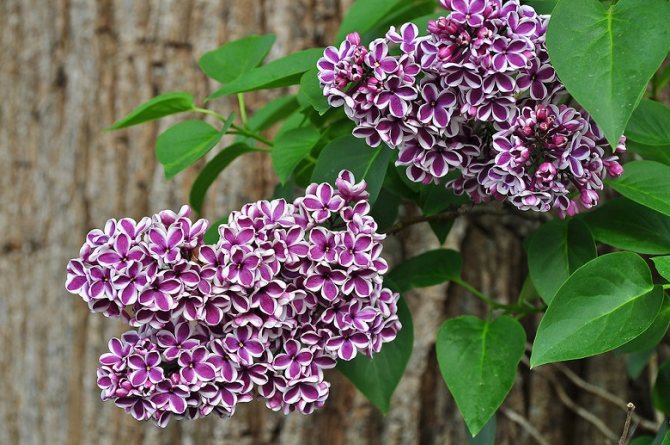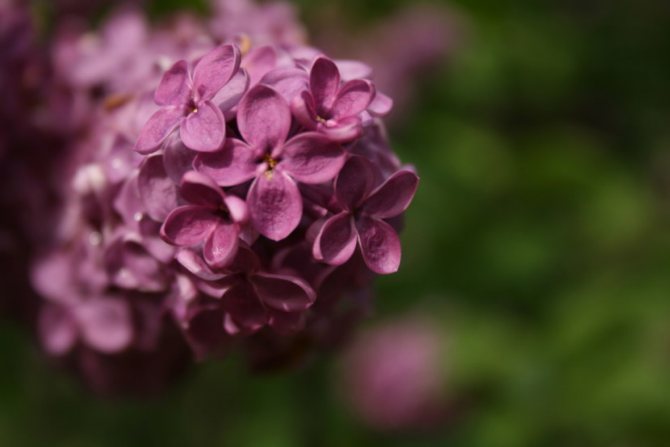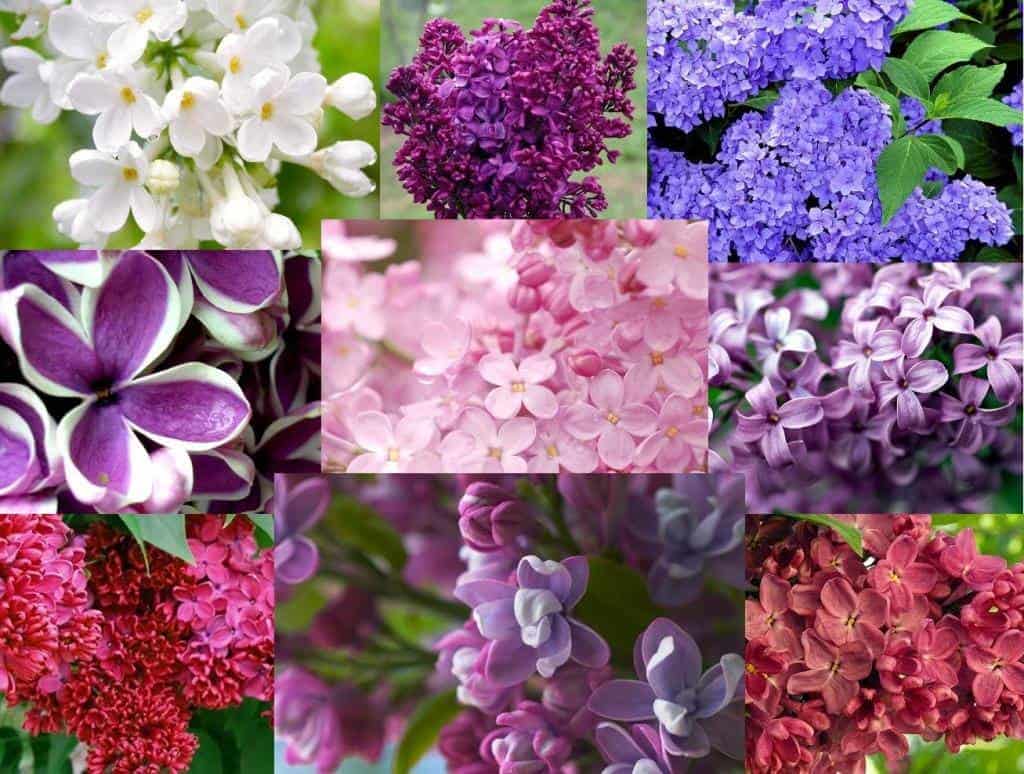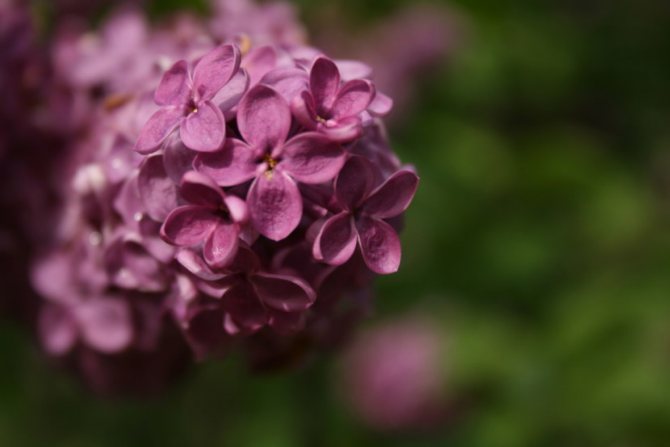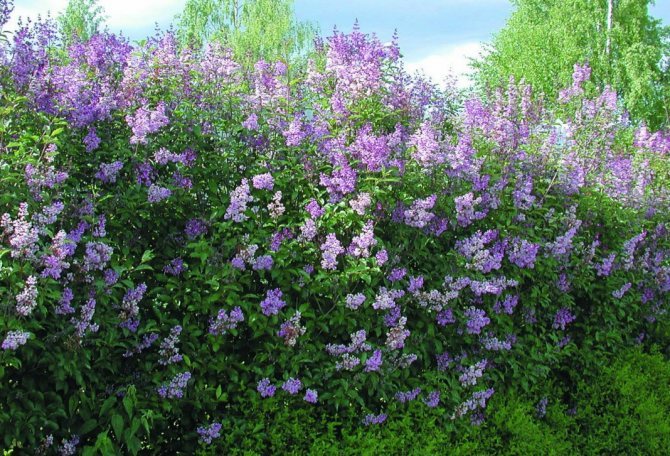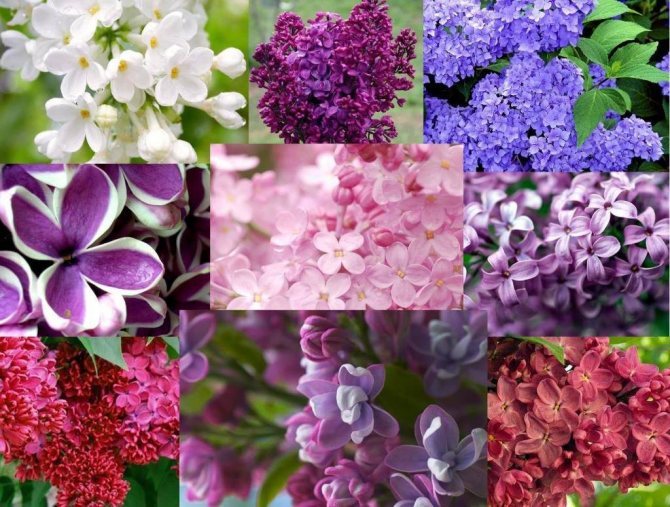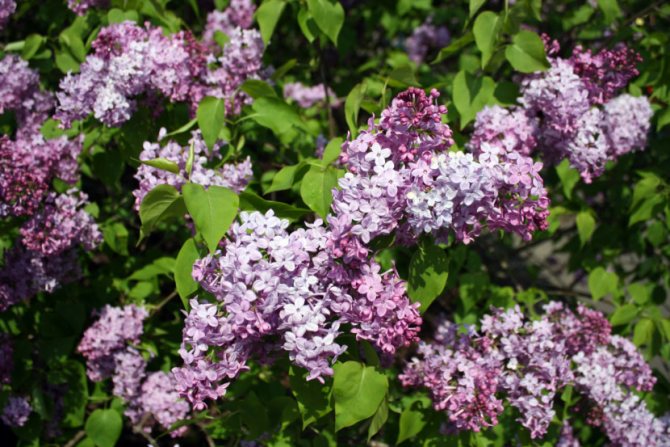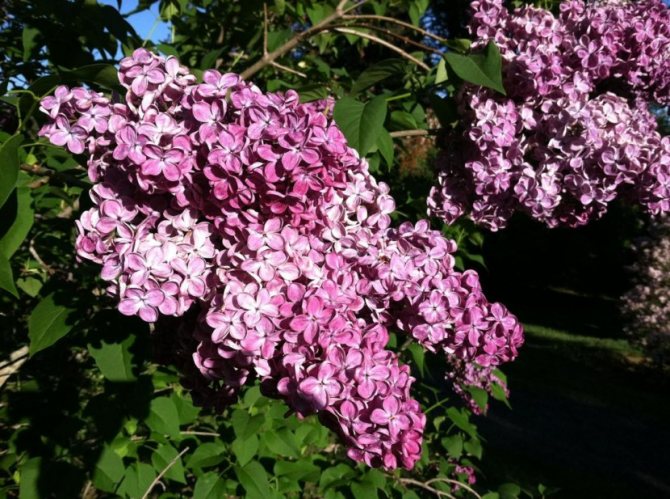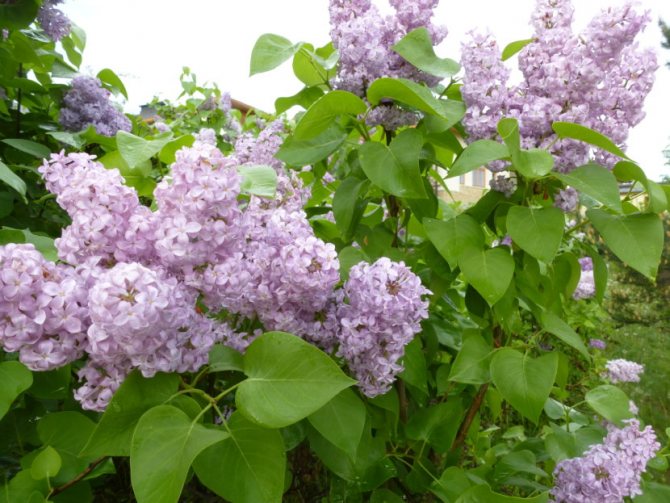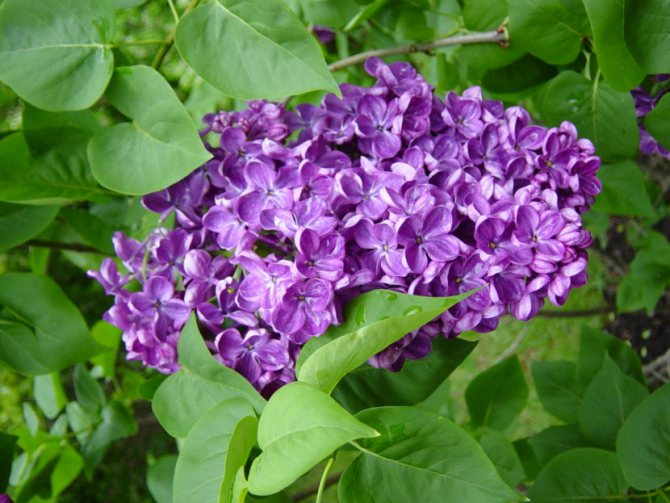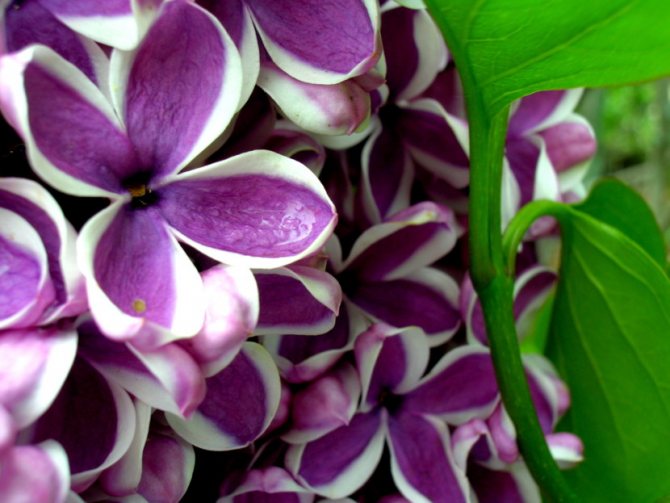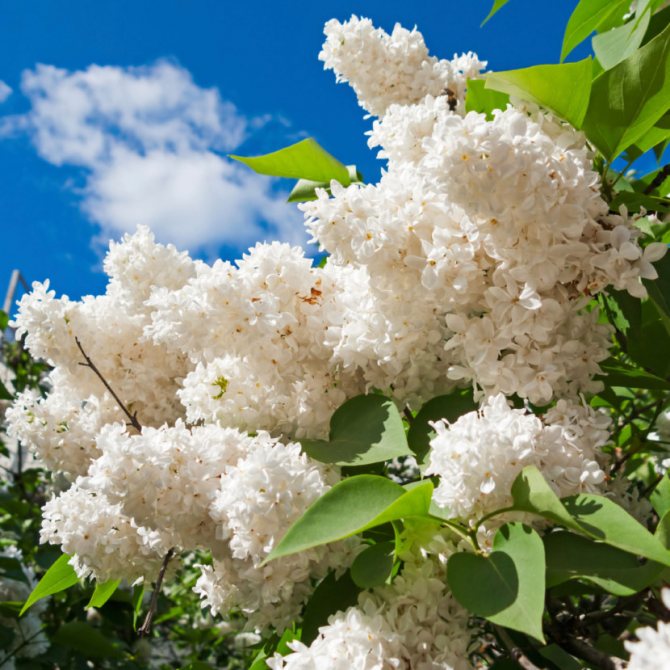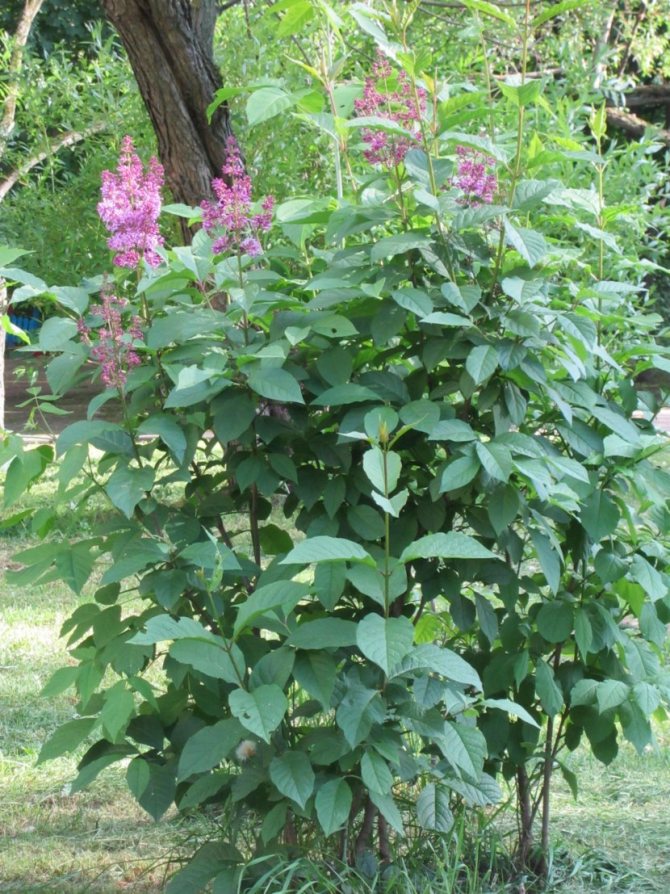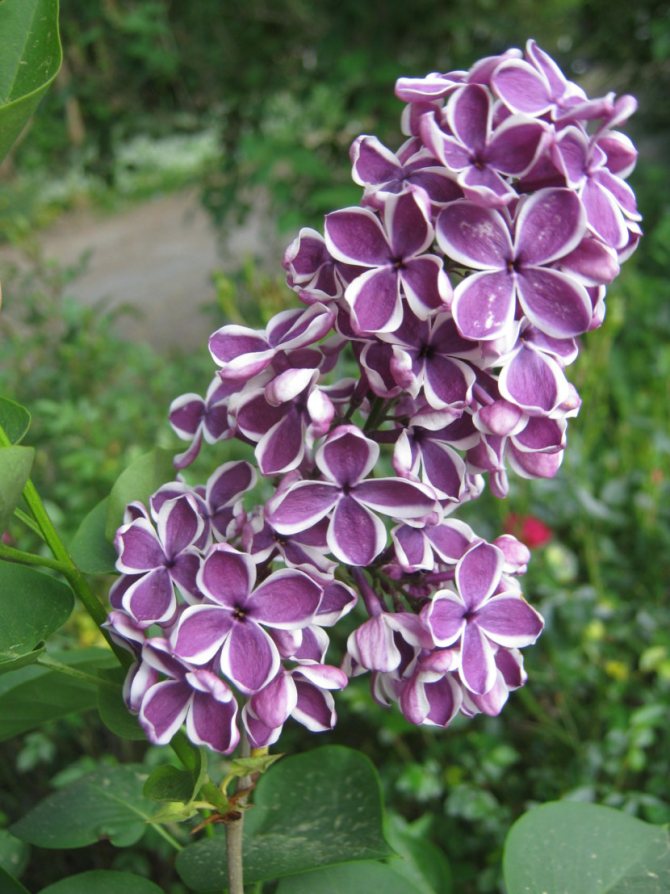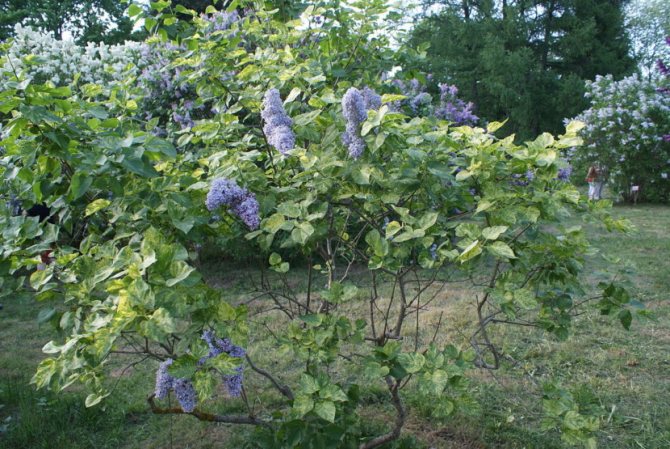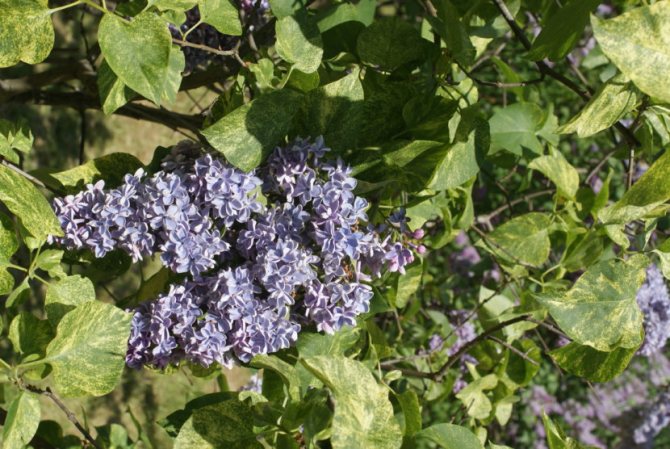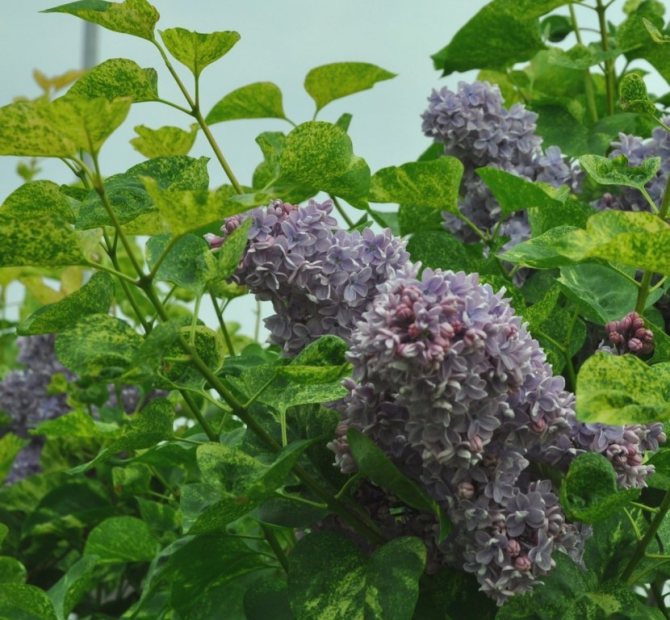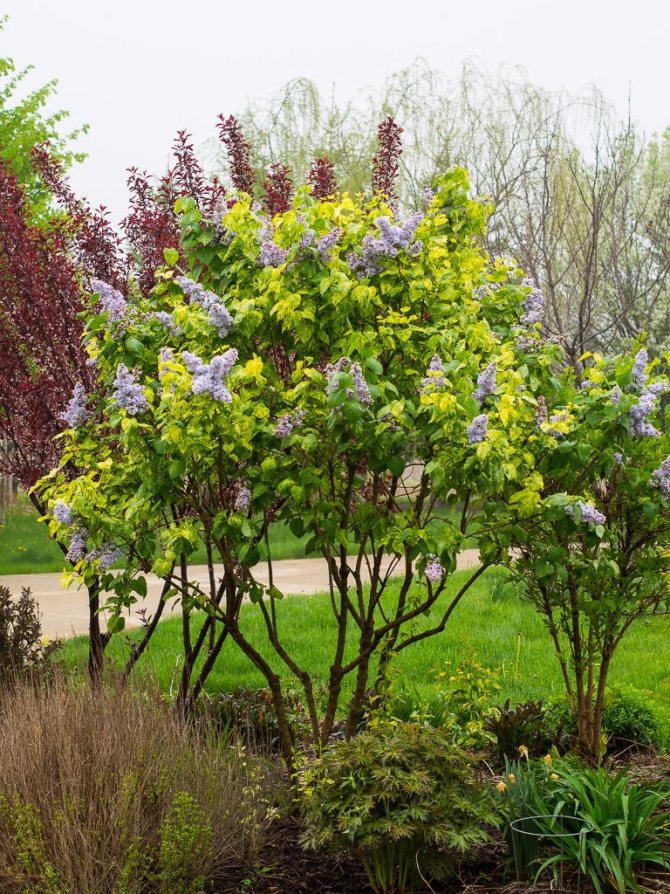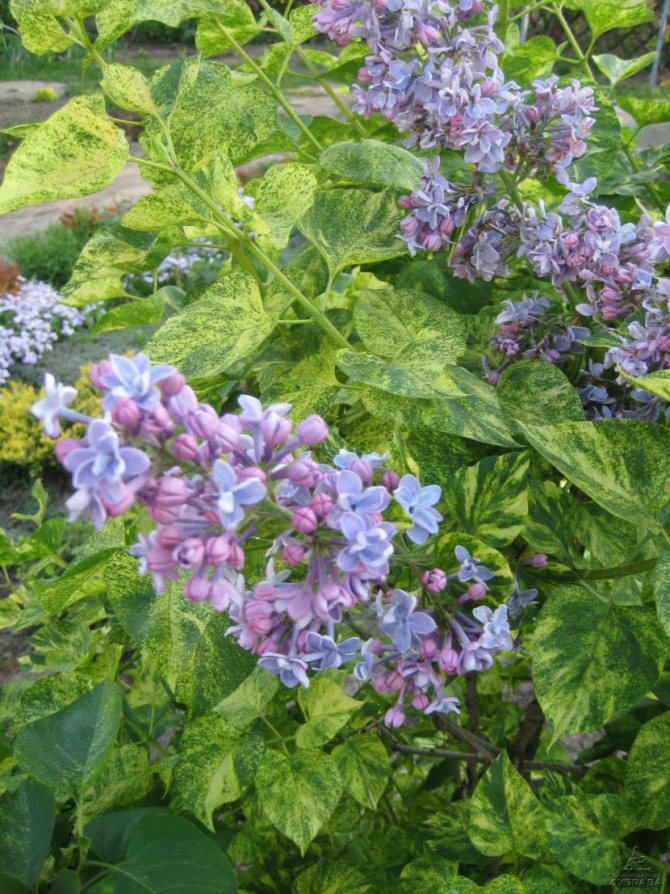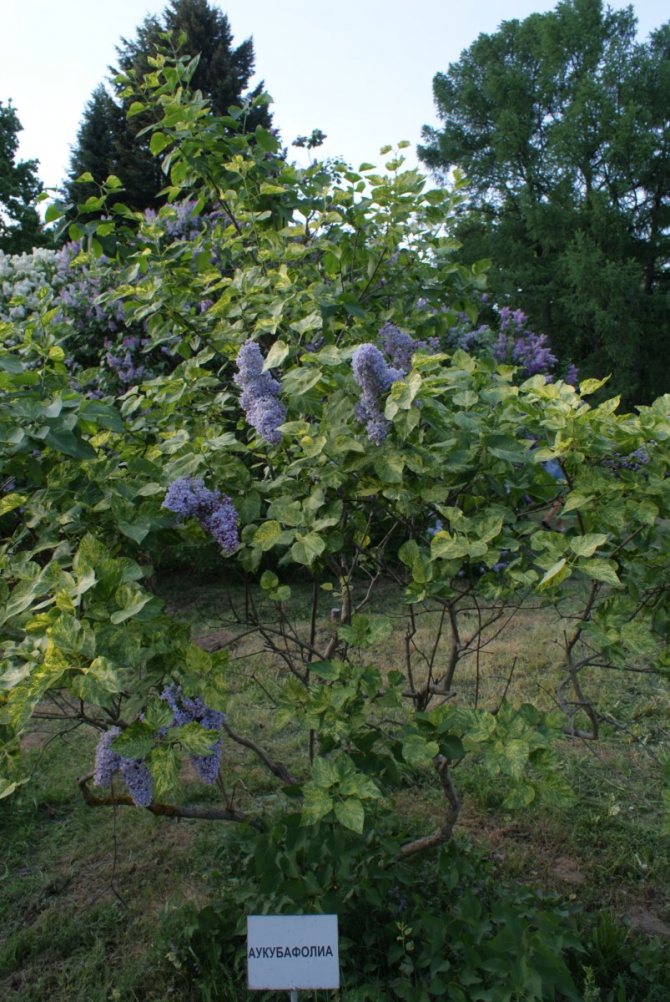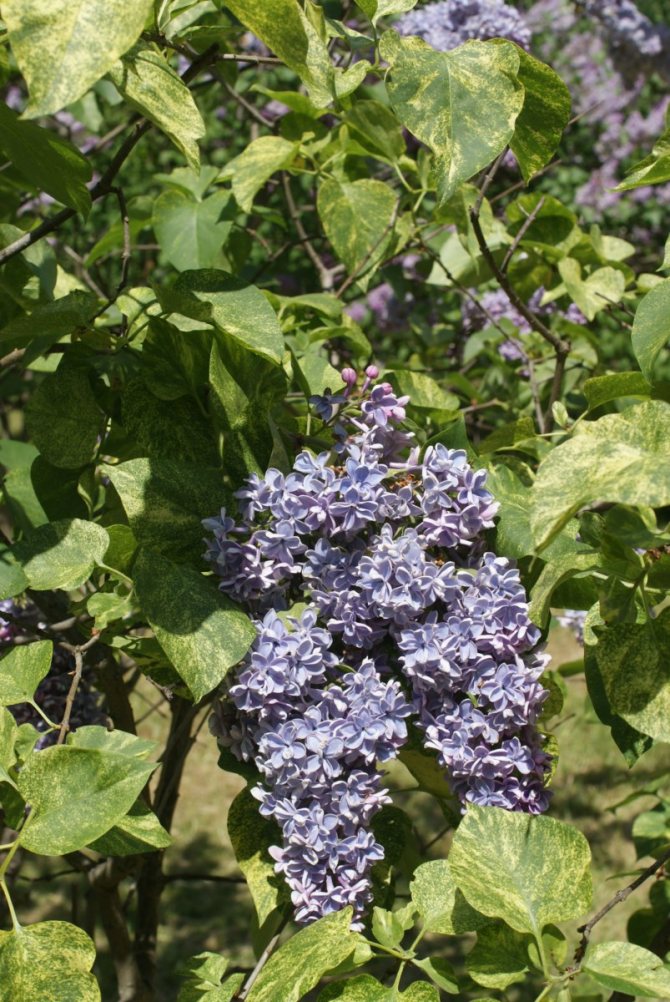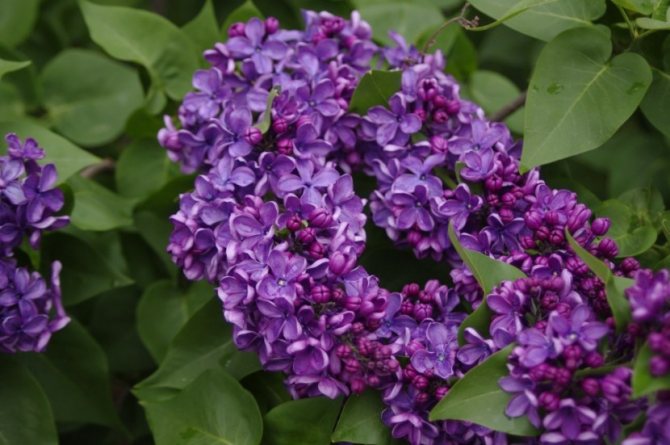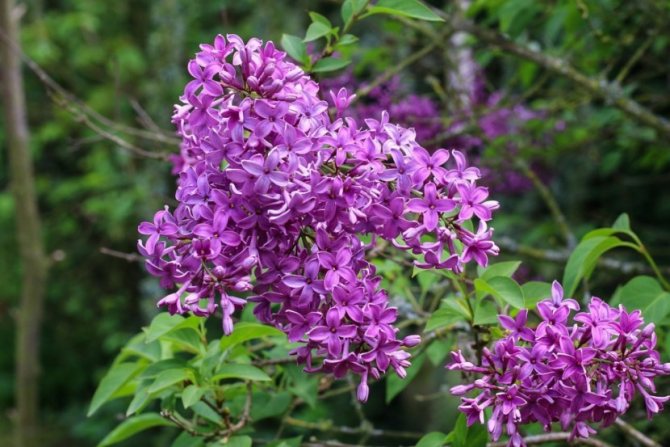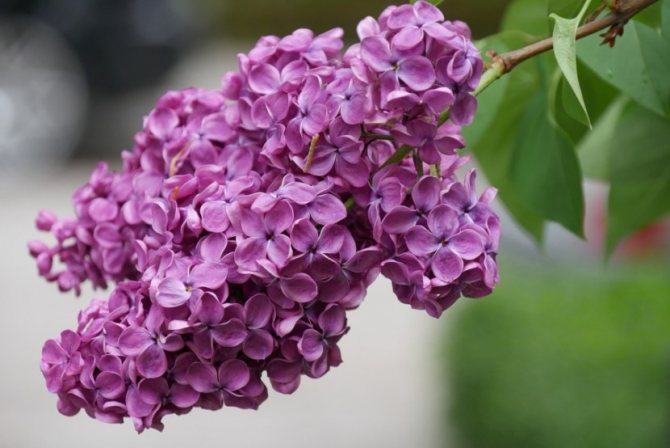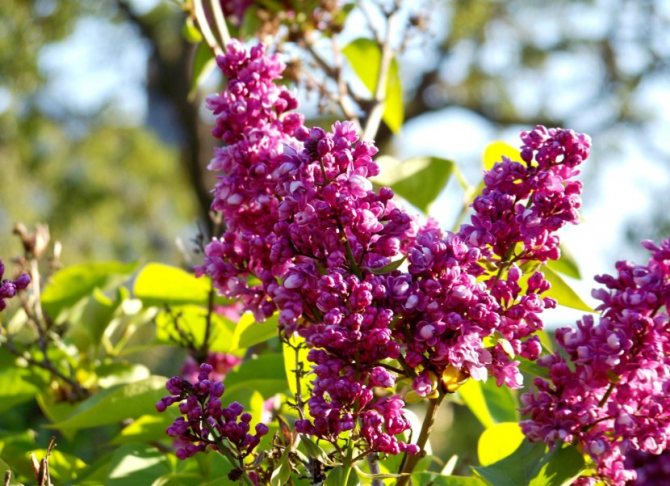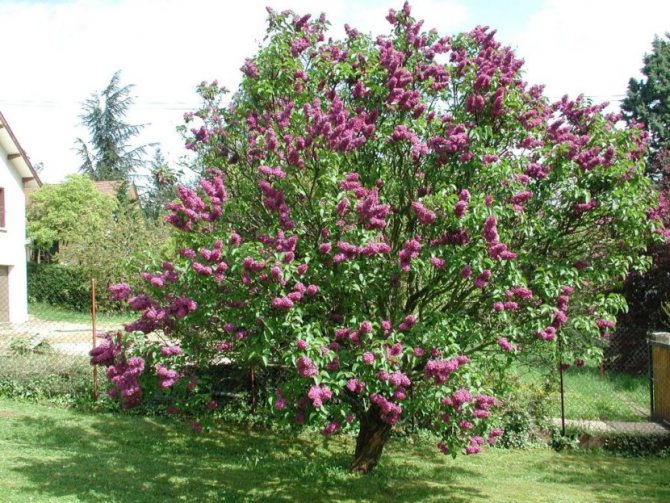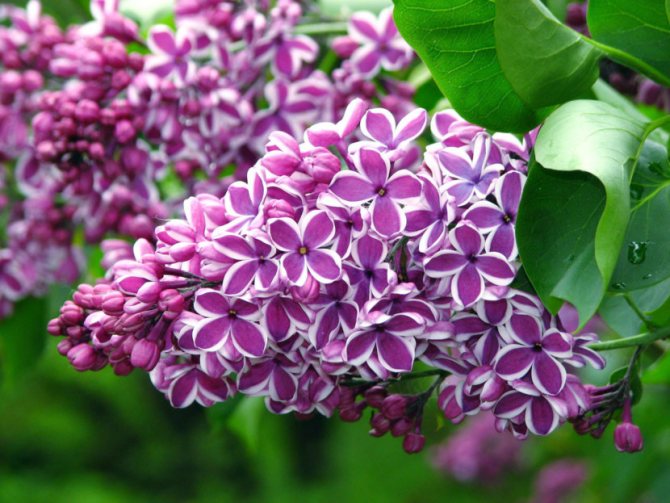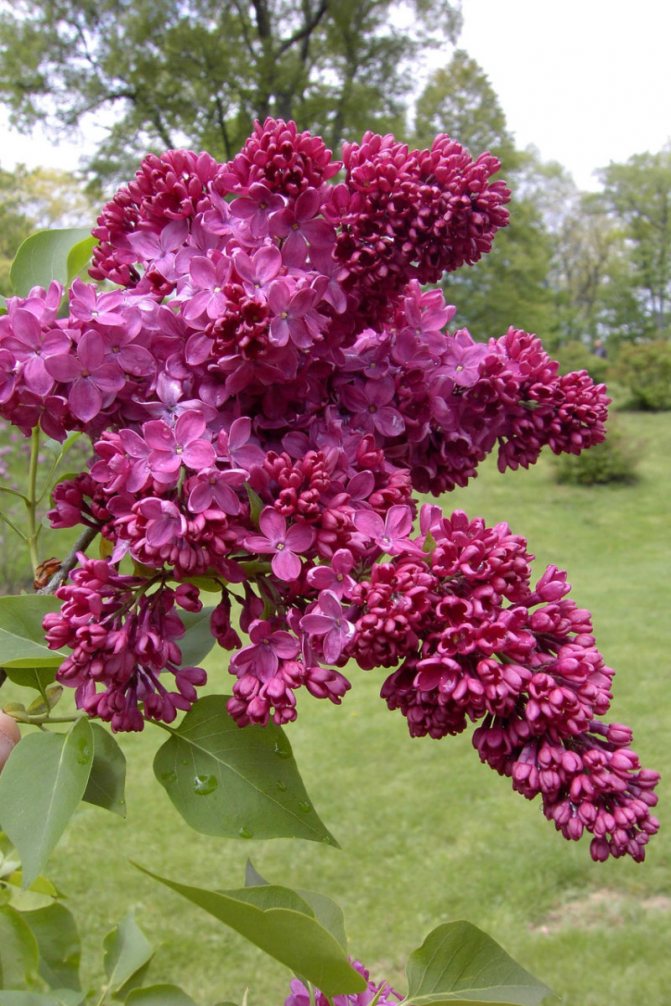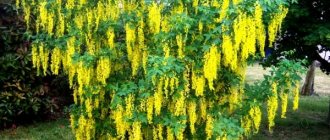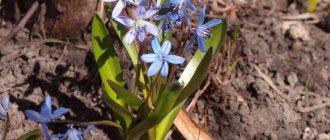Lilac is usually perceived as a homogeneous group of plants, but it has quite a few different types and varieties.
And one of the varieties of lilac, which is deprived of the interest of gardeners, although it is able to surprise with its flowering, later than that of other species, and other advantages, is Hungarian lilac.
It is a small shrub, suitable even for very small gardens, and has aesthetics, versatility and ease of care, as well as unpretentiousness.
Types of lilacs: general description
The name of lilac in Latin is Syringa. It comes from the Greek word syrinx. The exact translation means - "tube". Apparently, this name reminds of the structure of the flower itself. However, there is also a more romantic, actively disseminated version: the forest nymph Syringa was turned into a reed, after which Pan, the god of the forest, made a pipe out of him, which began to emit divine sounds.
In the wild, lilac, the species and varieties of which are well known to scientists, is still found everywhere. Especially in China, the Balkans and the Carpathians. More often it is Hungarian, tree and common lilacs. The homeland of the Himalayan lilac, as well as Afghan or Persian varieties, is the Himalayas. However, most of the species are native to Primorye and Priamurye, as well as Japan and China.
When we look at all types of lilacs, photos with names, we immediately notice their common property. Unusually beautiful and lush bloom. In species of wild lilac, most often the petals have a lilac-bluish color. Their color is original and unique, however, the color of the corollas is different for cultivated and hybrid varieties. It can be bright purple-violet inflorescences, bluish or lilac-pink flowers, completely pink or snow-white. Varieties with dark purple petals with a small white border look spectacular.
Small fragrant flowers are collected in large paniculate inflorescences. The flowers themselves are not only simple, but also double and semi-double. Lilacs have large varietal flowers: more than three centimeters. Certain varieties of lilacs have beautiful and elegant panicles. They look straight up, some have very wide bunches in size, dropping low from their weight.
All representatives of the genus are perennial plants. Usually they look like tall bushes, less often - low trees. The leaves are arranged in pairs (sometimes three leaves), in most species are simple and cordate, but in several species they are feathery. They fall in the fall.
Speaking about what types of lilacs are, it should be noted that there can be several classifications. And that's not it. All similar types of lilacs are combined in groups, they have similar names. For example, there is a classification of lilacs that is understandable to everyone according to the varieties of color of inflorescences. In catalogs, when describing a particular variety, as a rule, they indicate its belonging to one of the colors (for example, white, purple, lilac-pink).

Detailed description
The dark bush Andenken an Ludwig Spath is straight and tall. It is decorated with large flowers that form inflorescences.This variety has a wonderful aroma.
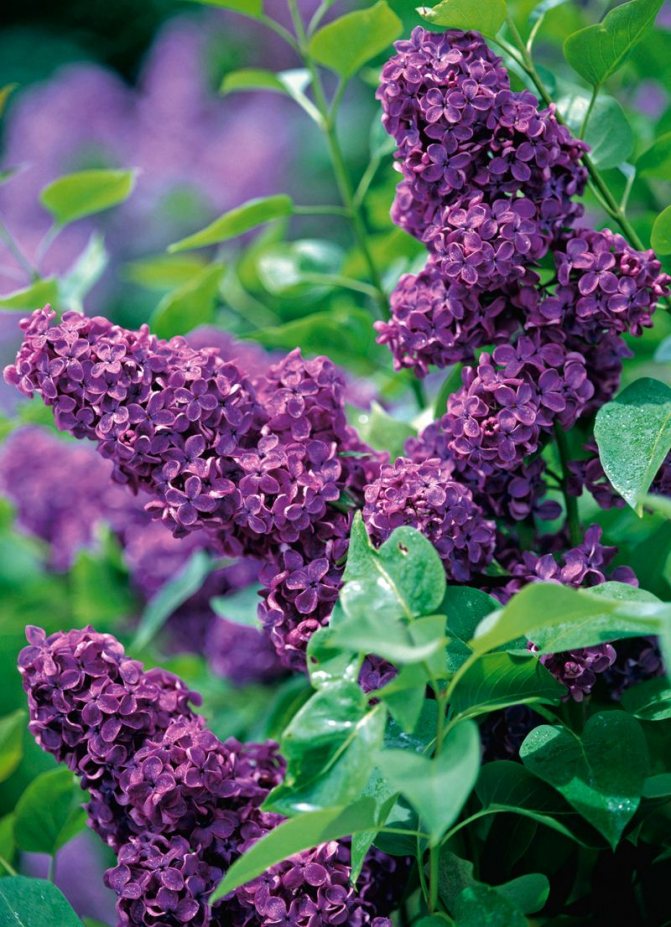

The foliage of the Aucubaefolia plant is unlike other species. The lilac branch will remind many of the Japanese Akuba. The leaves are decorated with peculiar patterns with golden-yellow dots with stripes. Fragrant semi-double flowers are painted in lilac-blue color. The bushes can reach a height of 3 m.
Charles Joly is another tall shrub. The purple-purple color of the terry inflorescences is immediately striking.
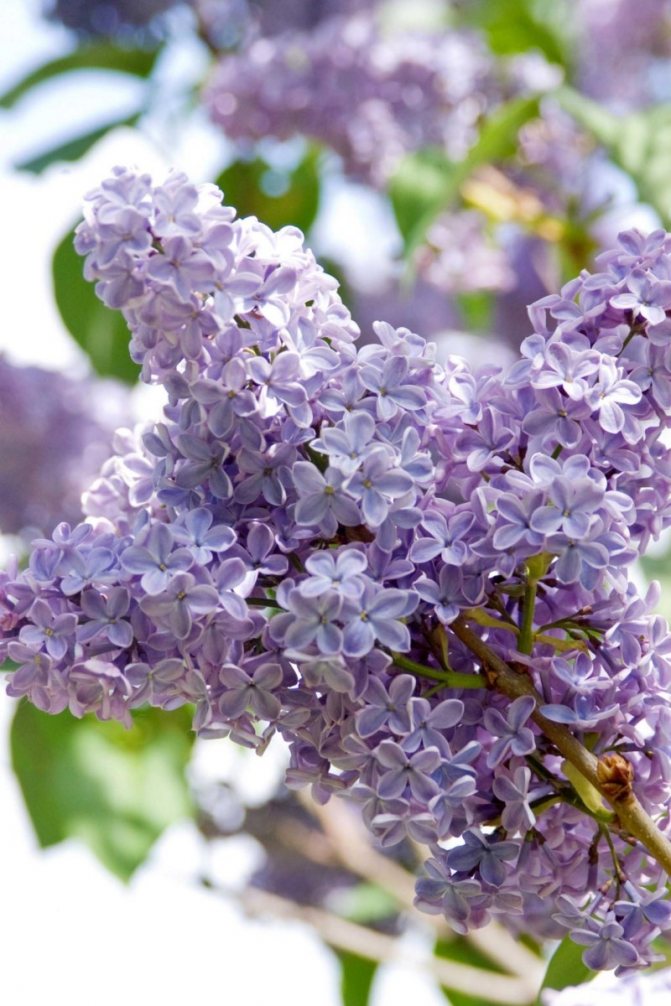

Monique Lemoine is a true masterpiece created by the Lemoines. A medium-sized bush produces white panicles. Densely double flowers consist of large, pointed petals.
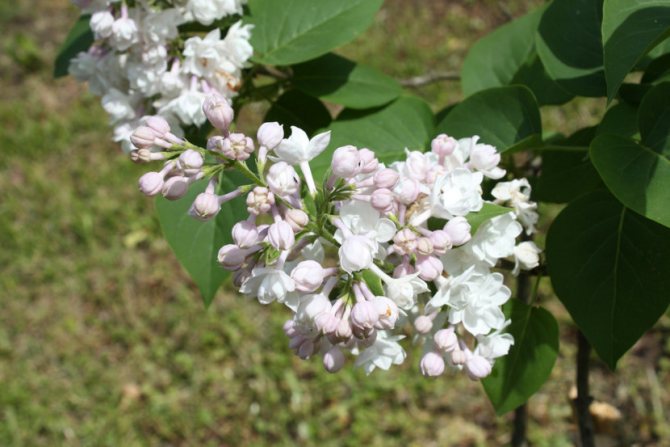

President Grevy pleases those around him with abundant flowering. Beautiful inflorescences on tall bushes are formed by semi-double flowers. The petals are colored lilac blue.
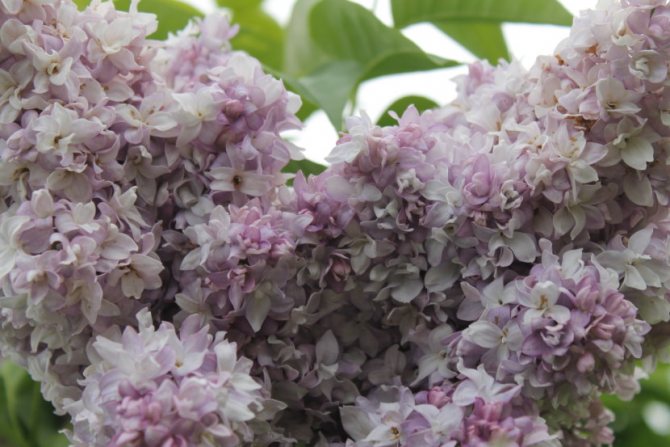

The Sensation variety differs from the others in its unique color. The purple-red petals have a white border along the very edge. From a distance, the contrasting color is not so noticeable, therefore it is better that the lilacs are planted on the site next to the garden paths.
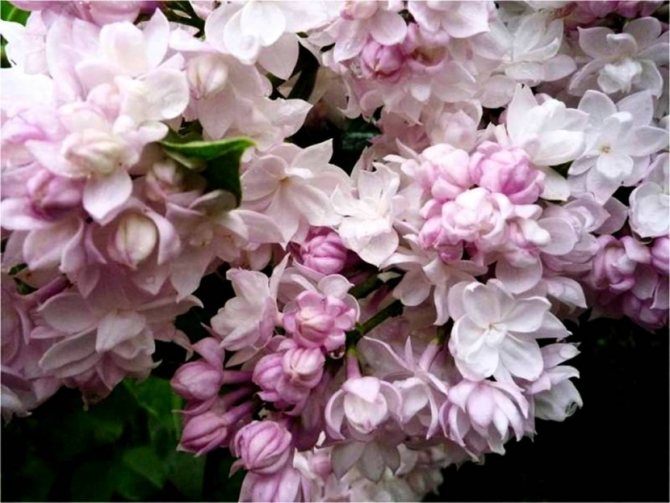

Gortenziya is a variety with lilac-pink flowers that combine into beautiful inflorescences. Lilac looks like panicle hydrangea.
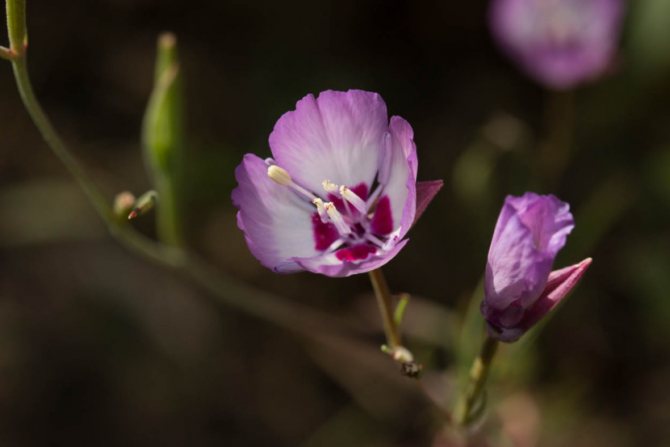

Clarkia graceful - varieties and types, care and planting, diseases + 78 photos- Irises - description of the species, cultivation, reproduction + 102 photos
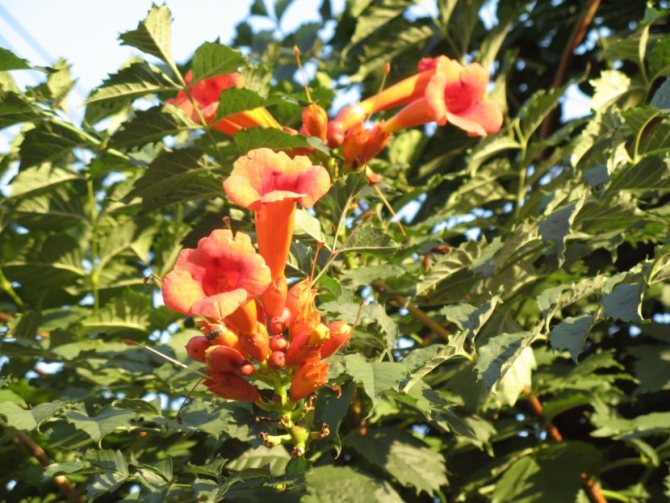

Campsis - planting, care, location rules, watering, types of reproduction (67 photos + video)
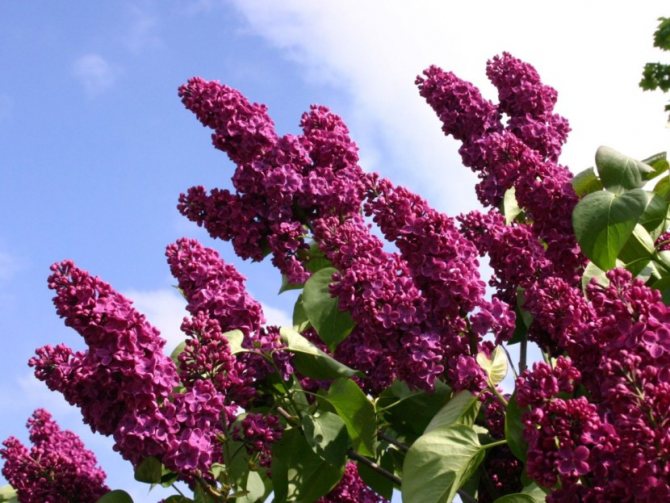

Indiya - medium-sized bushes, reaching a height of 2.5 m.Simple flowers with a violet-purple color have a reddish tint.


Olimpiada Kolesnikova is a variety of extraordinary beauty. When the lilac blooms, sharp-pyramidal inflorescences bloom. Delicate mauve flowers combine to form buds. The height of the bushes can exceed 3 m.
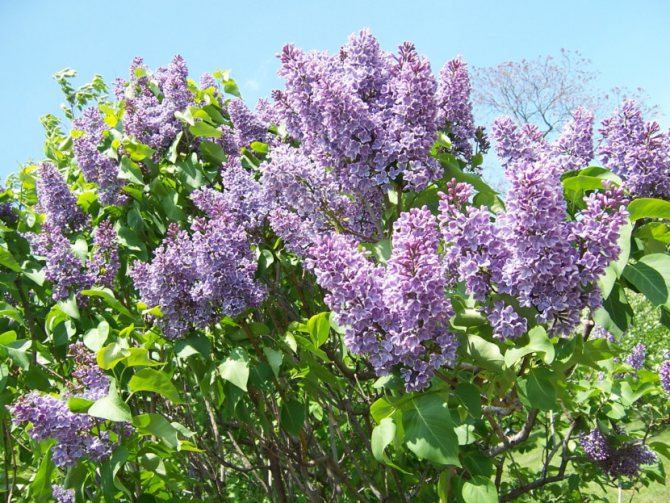

Common lilac varieties
A bit of specifics. Almost all varieties of common lilac have four-petal flowers in inflorescences of about one centimeter. They are formed on the buds of last year's shoots. The most popular and adored by everyone, common lilac is widely known. And there is no need for additional descriptions.
Common lilac species have been cultivated since the eighteenth century. During this period of time, many varieties have been bred. She blooms first. The bush can grow up to three meters in height, it is unpretentious to soils, it grows in any conditions. Common lilac in cream shades or white has a characteristic delicate special aroma. The bush is very beautiful during its flowering: small and unusually fragrant flowers, most often bluish-lilac shades, are found in large paniculate inflorescences, three or five pieces in each bunch. It blooms in May or June, depending on the region.
At the moment, breeders have bred a huge number of varieties of common lilac. There are also dwarf ones (variety "Gnome"). There are also real masterpieces: for example, the world's only bright yellow lilac Primrose. This type of lilac is in the photo below. A large two-meter bush blooms very profusely. True, by the end of flowering, the yellowness fades out, and the inflorescences become white. You can endlessly study the types of lilacs, photos with the names of varieties, but one thing is for sure. Each of them is beautiful in its own way.
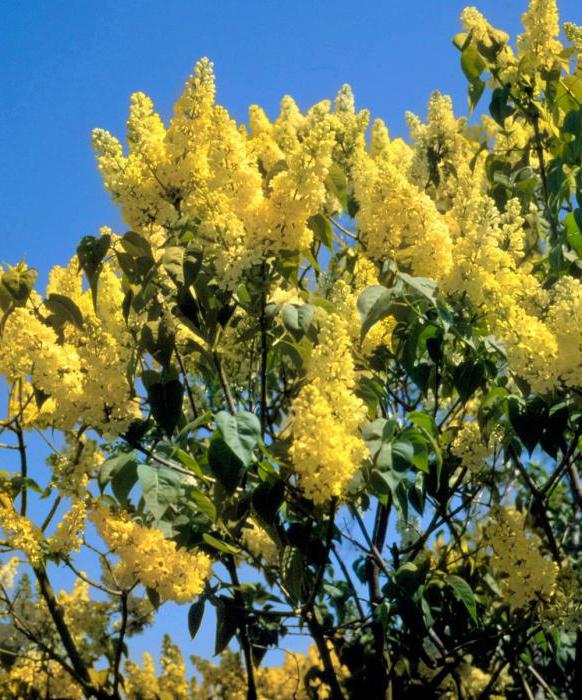

Planting and caring for Hungarian lilacs
Like any other tree, Hungarian lilac can only grow with proper care. To create favorable growth conditions, it is necessary to take into account all factors - planting rules, soil preparation, etc.
Recommended timing
Planting Hungarian lilacs can be done both in spring and in autumn. If you plant seedlings in the period from mid-July to the end of August, then you can expect an active growth of the shrub in the very first season.
It is not worth planting a crop in early spring and autumn, because at this time the soil contains a lot of moisture, which has a detrimental effect on the condition of the plant. Young roots can rot or severely slow down their growth.
Attention! Planting lilacs should be carried out in cloudy weather or after sunset.
Site selection and soil preparation
Lilac common Hungarian loves sunlight. Therefore, when choosing a landing site, this factor should be taken into account. The site for planting seedlings should be well lit, but closed from winds and drafts, which have a detrimental effect on the shrub.
To the soil "Hungarian" is not demanding, but it is not worth planting it in swampy or clay substrates. The roots of the shrub quickly rot from excess moisture, which leads to their death. It is best to choose an area with fertile soil that is well-drained. The composition of the soil can be either neutral or slightly acidic.
Under favorable conditions, Hungarian lilac (in Latin Syringa josikaea) can live for at least 100 years. During her lifetime, she manages to bloom at least 90 times.
Attention! It is important to know that planting lilacs should be carried out in the holes. Their size also depends entirely on the composition of the soil - a sandy substrate involves digging holes measuring a meter by a meter, a fertile substrate - 50 by 50 centimeters.
How to plant correctly
In order for the lilac to take root well and can grow unhindered, it is necessary to take into account the basic planting rules:
- the distance between seedlings should be, on average, 2.5 meters;
- landing pits should have sheer walls;
- it is necessary to add a substrate to each well, which contains components such as compost, humus, superphosphate (if necessary, additional acidification of the soil) and wood ash.
Procedure:
- The substrate (its components) must be thoroughly mixed and a small part poured into the hole for planting.
- For seedlings, the crown should be shortened: depending on the height of the planting material, up to 3 buds are removed.
- If the roots of the seedling are too long, they can also be trimmed a little. Ideally, the length of the roots should be no more than 30 cm.
- The seedling must be positioned in the center of the created depression.
- Spread out all the roots.
- Sprinkle with the remaining substrate, tamp a little.
- Water abundantly.


Broad-leaved lilac
These bushes have much larger leaves. Landscape designers love them as they take on an attractive magenta color in the fall, and this is how they decorate any garden area. A tall (up to three meters in height) plant of the correct shape can be either a shrub or a tree. The broad, heart-shaped leaves are usually about ten centimeters long. Conical inflorescences up to twelve centimeters in size are most often painted in a pale purple or violet-lilac color.
This is how broad-leaved lilac looks like, the types and varieties of which are usually inferior to ordinary ones in the beauty and splendor of their flowering. But they bloom a little earlier. Already at the end of April, it is pleasing to the eye and exudes aroma in gardens and city parks. The inflorescence in these species has a slightly conical shape. Quite often there are buds of spectacular carmine-pinkish shades.
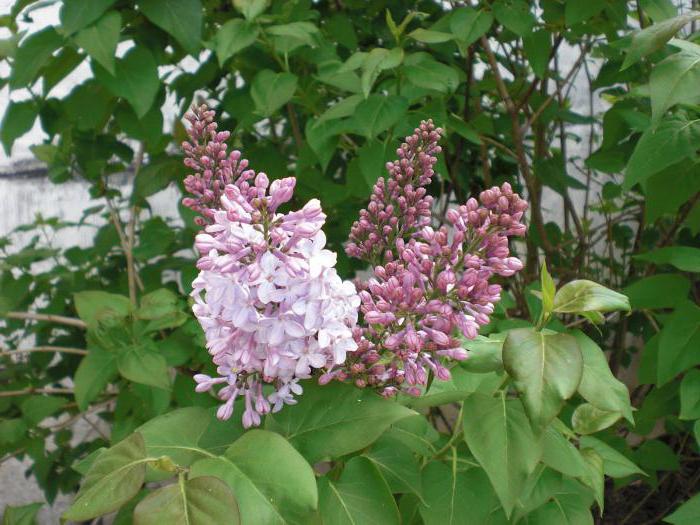

Varieties of purple terry lilac
Purple varieties are the smallest group. Perhaps because an ordinary shrub has a color close to the palette. From terry purple plants, Lemoine varieties prevail. He is considered the progenitor of the garden lilac. Purple varieties belong to the group of dark terry lilacs.
Violet
Violetta is distinguished from all by the structure of flowers. They are asymmetrical, from petals of different shapes. Each has sharp and not very, narrow and wide petals.The corolla is purple. The leaves are dark green. At the time of development, they are covered with a brown coating. Forms large inflorescences, each of which consists of 2-3 panicles. Blooms profusely. He is considered the best and most original in this group. Mid-flowering bushes are tall, straight.
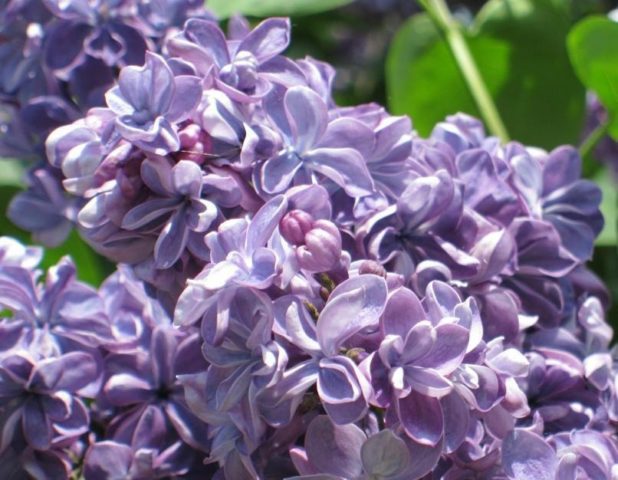

Katherine Havemeyer
The bush grows tall and straight. Possesses decorative qualities. Lilac leaves are large, have the color of dark greens. Forms 3 corollas with pointed petals. Their colors are lilac with a subtle pinkish tinge. In the lower part, the petals are more saturated. Corolla diameter - 3 cm. Pyramidal inflorescences, large, formed by 2-4 panicles. The flowering period is April-May.
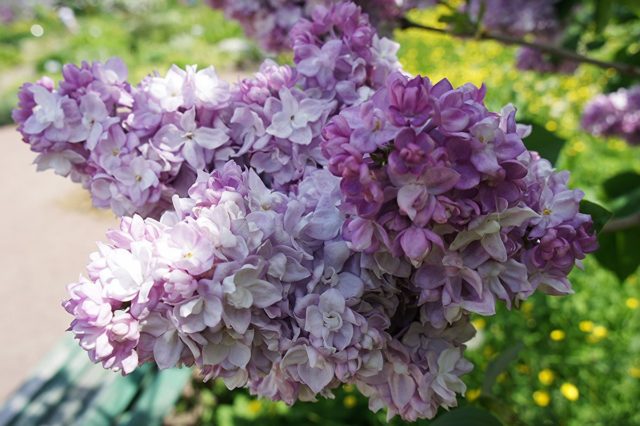

Maksimovich
The plant forms not very tall bushes, but their shape is spreading. The buds are colored silvery purple. Fully blossomed, they reach a size of more than 2 cm. Formed by three closely spaced corollas. Oval petals. The central part of the vertical petals covers the middle. Inflorescences are large, cone-shaped, formed by 1-3 panicles. Possess a scent. During the flowering period, forms many brushes. Medium flowering.
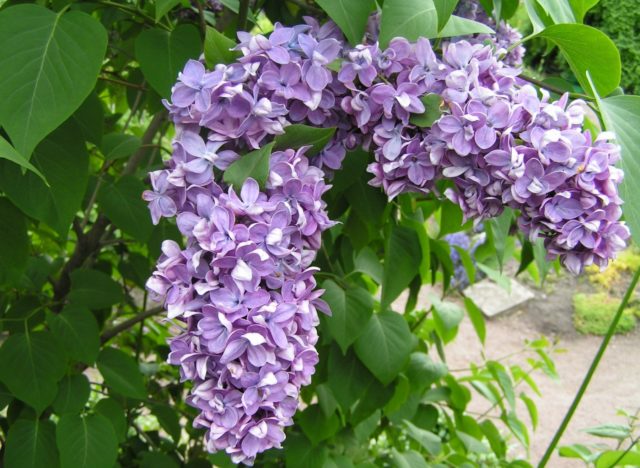

Antoine de Saint-Exupery
The variety is considered exquisite. The color of the buds is dark purple. The flowers themselves are asymmetrical, the central petals cover the middle part. They are located on long tubes, narrow. The color is intense, lilac-pink. Forms long pyramidal inflorescences. The shrub prefers sunny areas, tolerates partial shade. Dislikes highly humid places.
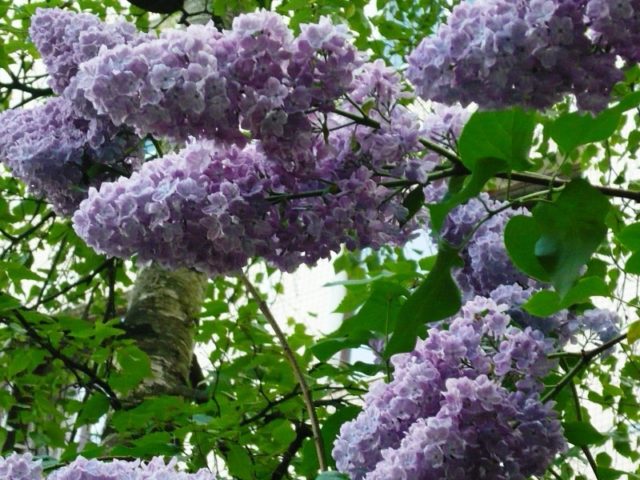

Lilac hyacinth
Another variation. Considering photos of flowers, types of lilacs, one cannot fail to mention hyacinthous varieties. Very few of them were bred - about five percent of all total world collections. For a long time this species has not been studied in any way, therefore, today only varieties obtained by crossing broadleaf and common species or two different plants of the same (hyacinth) species are considered hyacinthous.
Although hyacinthous lilac is not very common, its varieties are distinguished by the earliest and very lush flowering. In our regions, Buffon is a fairly popular variety. Also famous are the varieties, for the selection of which the pollen of lilac expanded broadleaf was used. The famous scientist, breeder from Canada, Frank Skinner, crossed with her an ordinary lilac, which has long grown in his home garden. As a result, twenty hybrids were obtained, which are now quite popular, since they differ in a very neat shape of their bush and thus fit into certain styles of landscape design. The types of hyacinth lilacs are not too spreading, moreover, they are resistant to temperature extremes. And also perfectly tolerate spring frosts.


Application in landscape design
The flowering of Hungarian lilacs is a real decoration of any site. Shrubs are planted along hedges, at the entrance to the garden, near the house and gazebos. The versatility of using lilacs in landscape design was also noted by professional designers, who suggest not only planting a plant in any convenient area, but also creating real compositions with its help.
Hungarian lilac can act as a hedge, acting as a real garden fence. To properly form a hedge, you need to take into account not only the size of the seedling during planting, but also how much the adult plant will reach. Therefore, it is necessary to allocate a large enough area of land for shrubs in order to ultimately get the desired result.


Fence organization rules:
- Plant the seedlings in holes, the distance between which should be 1.5 meters.
- In order for the shrub to grow evenly, it is not necessary to fertilize and prune it for the first 3 years.
- The introduction of top dressing begins at the 4th year of life.
- Watering is not required: there will be enough moisture from melting snow and rains.
- Pruning is carried out only to renew the bare bushes. But there should always be at least 10 strong shoots per plant.
The stamp form is also one of the options for planting lilacs. It is a little more difficult to organize a hedge, but it has its own aesthetic benefits.
Attention! The stem shape is a lush tree that is grown on an even trunk. The branches of the shrub fall down, forming a rounded silhouette.
To create a decorative bole, you need to take an ungrafted lilac. It is necessary to choose one suitable shoot, which has a height of at least 1 meter (the procedure is carried out in the spring). The roots of the plant should be cut in such a way that you get a square measuring 20 by 20 centimeters. A varietal lilac (Hungarian) should be grafted to the selected cuttings, and in the autumn period the bush should be dug up and planted on the prepared site. All root growth must be removed.


Hungarian lilacs can be planted in areas with other plants. The most favorable neighbors are: tree peony, viburnum, lupins, hydrangea, phlox, spruce and other conifers, perennial shrubs and evergreens.
The culture can be planted:
- in one group with shrubs;
- in sirengaria (when a planting is organized, consisting of varietal and specific lilacs, which replace each other with a flowering period and differ in color);
- in flower beds of various sizes;
- in arrays;
- in discounts;
- for vertical accentuation of beautifully flowering compositions.
Types of white lilac
Sometimes only breeders and professionals can distinguish the color range of buds from one another, so it is difficult to point out the exact differences between varieties. In general, white lilac is called such only conditionally, since there are many shades. Their color is intense only in the bud. Terry varieties of white lilacs are very numerous. You see below in the photo a view of white lilac. Its descriptions are also given.
From the classic varieties, one should recall M. Lemoine's lilac. It was bred in the nineteenth century, it is distinguished by thick double flowers. At the moment, this variety, despite its age, is the best and most stable. As it grows, the plant forms into a large three-meter bush showered with flowering bunches, striking in its beauty and grace.
Many varieties of white lilac are bred by Belarusian breeders. Some of them have received worldwide fame. The Rochester variety (non-double) was obtained back in 1971. However, he entered the top ten of the common white lilacs in the entire world collection. A small one and a half meter bush blooms with creamy buds, but as it unfolds, the buds gradually turn white, and a small waxy bloom becomes noticeable on the petals. But the main feature of this amazing variety is its large three-centimeter flowers with twenty-five petals.
In general, the types of white lilacs are much more capricious than their colored relatives. They require more careful conditions during the cultivation process. Recently, monochrome monochrome plantings have been popular in all modern gardens. In order to admire the magnificent plants for a long time and enjoy their aroma, it is advisable to plant a large number of types of white lilacs. It all depends on the timing of its flowering.


Color classification
The most convenient, because in many species there are varieties with the same color. And so you can collect the best varieties of a given color in one form.
White lilac "Madame Casimir Perrier"
An ancient French variety, created by Lemoine back in 1894 and is still popular.
- Sprawling bush up to 4.5 meters high, crown diameter about 2 meters. The leaves are long, up to 10 cm. Inflorescences in the form of a pyramid with creamy buds and about 20 cm in size. The buds bloom into dense double flowers, each with 3 - 4 corollas.They resemble white snowflakes.
- It is better to plant such a variety in a sunny place where there is a little shade. The soil should be fertile, with a high humus content. Too much moisture can kill the plant.
- Quite frost-resistant for the Moscow region, blooms in late May and early July for about three weeks. It can burn out in the sun, so you need to choose a place for planting carefully.
- The variety is suitable for early spring forcing and can delight women by March 8th. One of the best varieties that blooms every year and for a long time.
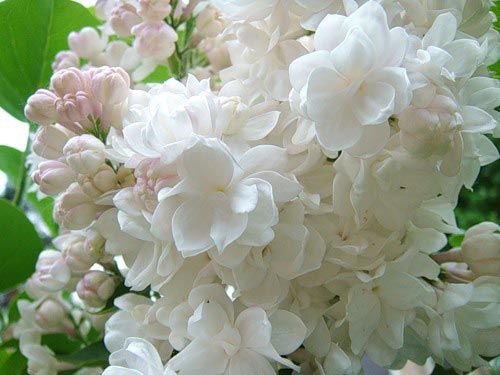

Yellow lilac "Primrose"
This is an amazing and unusual sight. This color is not peculiar to lilacs. Refers to the species - Common Lilac. But this look assumes a completely different color with pigments of pink, lilac, burgundy tones. White corollas without pigment at all. Where did the yellow come from?
In 1949, in Holland, a new unique and so far only Primrose variety was bred from a variety with a kidney mutation. For its uniqueness, this variety has received a First Class Certificate.
- The shrub is up to 3.5 meters high. Has a spreading crown. It grows quite quickly - up to 30 cm per year.
- The flowers are similar in shape to ordinary lilacs, slightly elongated and inflorescences up to 20 cm long. Very delicate yellowish color. When they grow in the sun, they can fade to white, that is, they return to their basic appearance and white color. In mid-May or early June, the bush begins to be covered with a gorgeous hat.
- They are planted in an open place, loves warmth, but does not like wind, partial shade is desirable. The soil should be humus (slightly acidic or neutral). Lime must be added to the acidic one. If there are several bushes, then you need to plant at a distance of 1 meter from each other. It is unpretentious in leaving and does not require special attention. In the early years, water no more than twice a week, sometimes fertilize with urea, and in the spring with superphosphate.
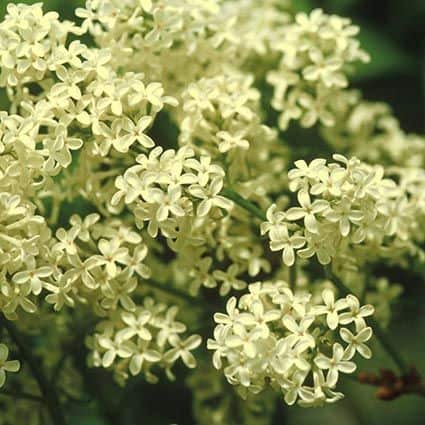

Purple lilac "Cosmos"
One of the best varieties of this color is known to many. Released in 1956. The height of the bush is from one and a half meters to two. If you plant more than one bush, then the distance should be at least 2 meters.
- The branches are straight, directed upwards. Shoots are long. The color is purple with bluish tints, yellow stamens in the middle. It has a very simple flower. The rim size is 25 - 30 mm.
- Usually has 2 pyramid-shaped brushes. The length of the brush reaches 25 cm. Sometimes there are 4 or 6. Flowers are located close to each other.
- Fruiting every year, average duration. If planted in the shade, there are much fewer flowers.
- One of the most persistent and hardy varieties. Well tolerates bad weather and cold, does not break.
Included in the top ten purple varieties in terms of popularity and characteristics.
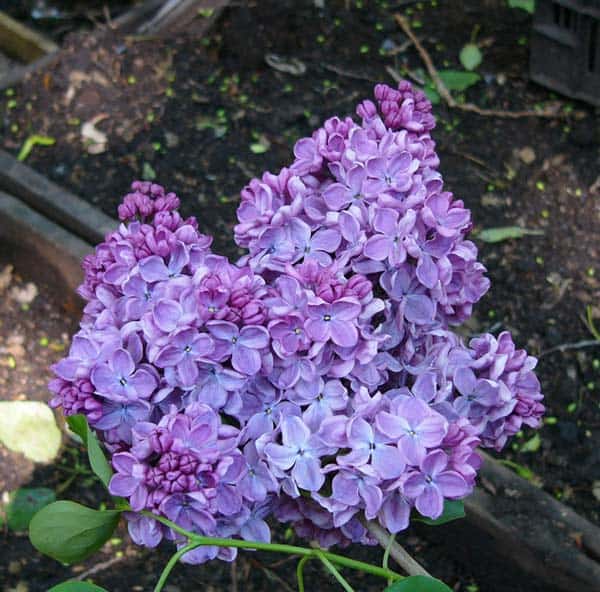

Blue lilac "Firmament"
There are several varieties that range in color from bluish to light pink. Let's take one of the best bluish lilac bushes for description.
The variety was bred in 1932. It is famous for its purity of tone and is well known. Differs in purity of tone and lives up to its name - it resembles a sphere.
- Refers to common lilac. The buds are bluish-purple, and the flowers are already pure blue. Diameter 2 - 3 cm. The petals are oval, oblong, the ends are raised up.
- The inflorescences always consist of one pair, medium density, strong, in the form of a medium-sized pyramid. The leaves are dark green in color, dense in structure.
- The branches stretch straight up, the average height is about two meters.
- It blooms very profusely every year.
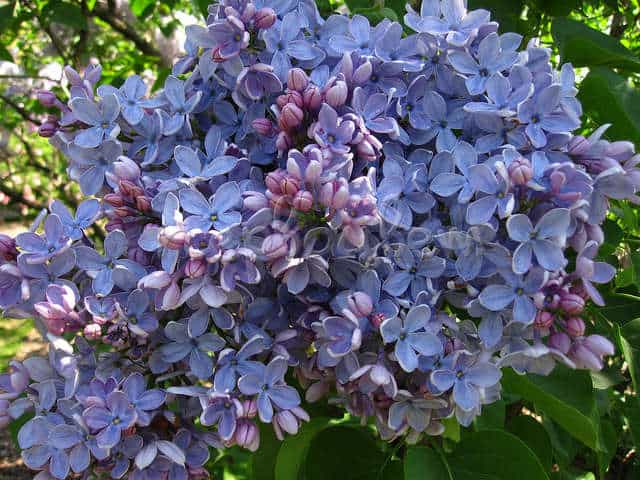

Red lilac "Red Moscow"
This purple handsome man occupies a special place. Bred in 1936 by L. Kolesnikov, the author of more than 300 varieties.
- The buds are bright with a purple tint, and the flowers are large, ordinary up to 2 cm dark purple in color with raised petals at the end. The tone is even and persistent.
- Usually the inflorescence consists of a pair of panicles, the length is average, up to 18 cm. The structure is dense and strong.
- It sometimes reaches a height of 4 meters, a width of h.It grows 20 - 25 cm every year.
- This lilac blooms in medium and moderate terms. Only very favorable weather conditions make it possible to increase the number of inflorescences.
- Quite unpretentious in the care. The soil should be low acidity or neutral.
- Can be planted in well-lit areas. The shade will not produce many colors. Dislikes drafts and highly moist soil.
A short video is offered where an expert will tell you some of the features of growing lilacs:
Fluffy lilac
Small, but very fragrant flowers of fluffy lilacs look unusual. That is why many people like it. Almost all varieties of this species have a slight pubescence on inflorescences and leaves. Similar to ordinary species, in fluffy lilacs, all inflorescences appear on last year's shoots from a lateral bud.
Each variety of fluffy lilacs is very beautiful. Plants look especially good on steep slopes, parks and large gardens. The bush of this species is small and compact, it is also ideal for a small garden area. In the wild, this type of lilac grows in some provinces of China. The lilac of the Julia variety looks especially gentle. Miniature flowers are combined into openwork inflorescences that cover the entire bush abundantly.
Landing rules
The second half of summer is considered a favorable period for planting seedlings - from mid-July to mid-September. In this case, the bushes will bloom next spring. If they are planted in the spring, then the growth of shoots will be slow and flowering will come only in the next season. Planting should be planned for the evening or on a cloudy cool day.
The shrubs are not particularly demanding for the composition of the soil, but they should not be planted in swampy areas or in lowlands where flooding is possible, since the roots can rot from dampness. The ideal soil for this lilac is a fertile, moderately loose substrate of slightly reduced or neutral acidity.
Shrubs are planted in pits about 0.5 m in diameter. Fertilizers are poured into the bottom of the pits: 1 bucket of humus or compost, 20-30 g of superphosphate, 300 g of ash. All components are mixed with the ground, and poured into the pit with a slide. A seedling is placed on this hill so that the roots are directed downward. It is covered with earth and slightly compacted at the base. The distance between the bushes should be 2-3 m.


Amur lilac
This species can still be found in wildlife in the forests of Northeast China or the Far East. The Amur lilac growing in natural conditions is simply amazing, since the plant reaches twenty meters in height. But cultivated varieties are about two times lower. Although this, in comparison with other species, is a lot.
The leaves of the Amur lilacs change their color: from green-purple in early spring to bright orange with the onset of autumn. The flowers of this species are collected in large paniculate inflorescences. But they are quite small, they can be cream or white in color, and have a characteristic spicy aroma. Flowering - very rich and abundant, but late. This type is suitable for landscaping urban gardens and parks, as it perfectly tolerates the difficult environmental conditions of a modern city, dusty and polluted streets nearby. Amur lilac is not afraid of temperature extremes and frost. It is unpretentious to soils.
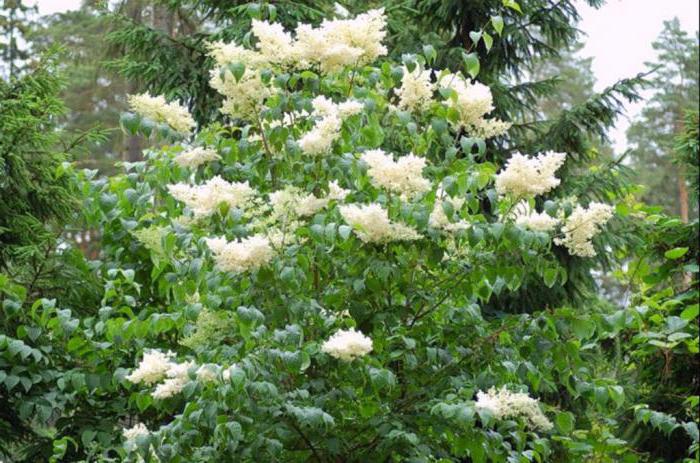

How Hungarian lilacs reproduce
A distinctive feature of the Hungarian lilac is that it does not give birth to offspring. In this regard, there are some difficulties with the reproduction of shrubs.
The main method is cuttings. As a material for propagation, not only green twigs are suitable, but also lignified ones. If you approach reproduction with all responsibility, then the seedlings take root quickly.
Another breeding method is seed. A prerequisite is stratification.In its process, simulate the winter period for 2 months, keeping the seed in the refrigerator. Sowing of seeds is carried out in autumn or spring. With careful care, the germination rate reaches 70%, which is slightly lower than when propagated by cuttings.
Hungarian lilac
It is impossible not to mention it. Speaking about how many types of lilacs there are, one cannot but mention the Hungarian, grown almost everywhere. Most often in big cities. Hungarian lilac in nature has recently been abundantly distributed, for example, in the Eastern Carpathians. It grows, as a rule, in humid places, along the banks of rivers and streams. But due to the draining of the land and the digging of bushes for transplantation, its number in wildlife is gradually decreasing.
Hungarian lilac is a shrub about three meters high with oval smooth leaves, pointed at the top. They are dark green at the top and gray-green at the bottom. Hungarian lilac blooms later than common lilac for about twenty days. It is appreciated by amateurs for its pleasant smell and long-lasting flowering. Flowers are located in sparse erect panicles developing from the apical bud.
Hungarian lilac is very unpretentious, it perfectly tolerates the difficult conditions of a metropolis, takes pruning in order to shape it, therefore this type of lilac is ideal for creating a green hedge. Most often cultivated varieties with pale purple inflorescences.
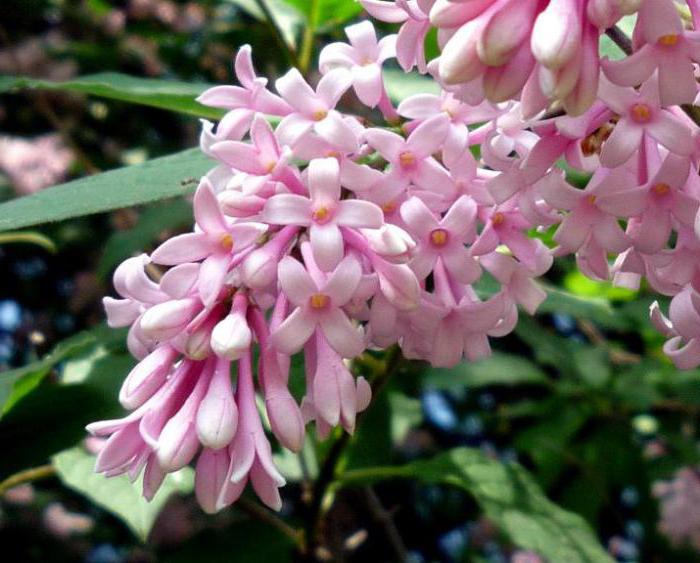

Forms and varieties of Hungarian lilac
Most of the lilac varieties were bred from the common variety. Hungarian does not have a variety of varieties; in horticultural culture, there are only a few of its forms.
- pale form - has a pale lilac color, which seems a little burnt out in the sun;
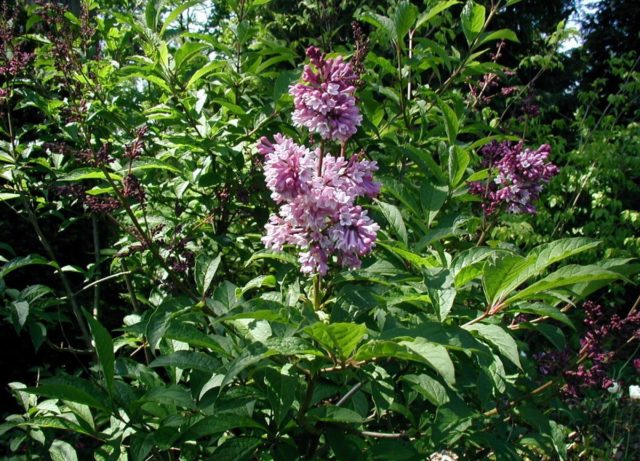

- red-flowered form - its color is bright purple, shimmering in a red hue;
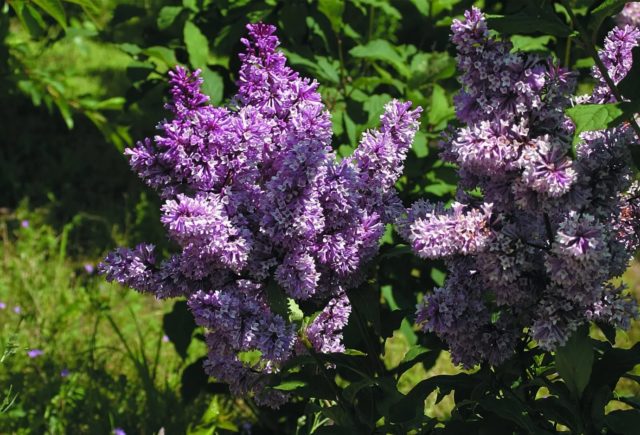

- white-flowered - Hungarian white lilac;
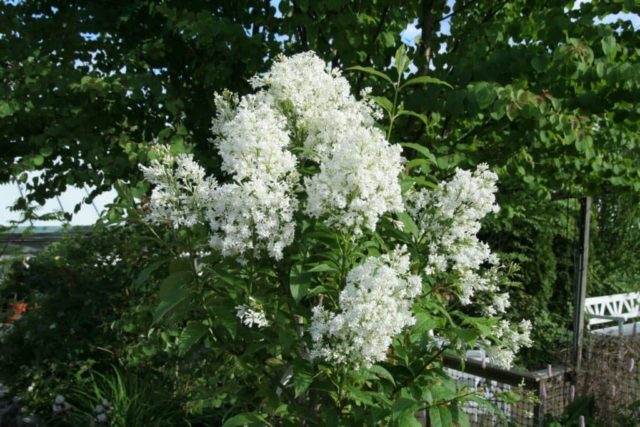

- rosaceous.
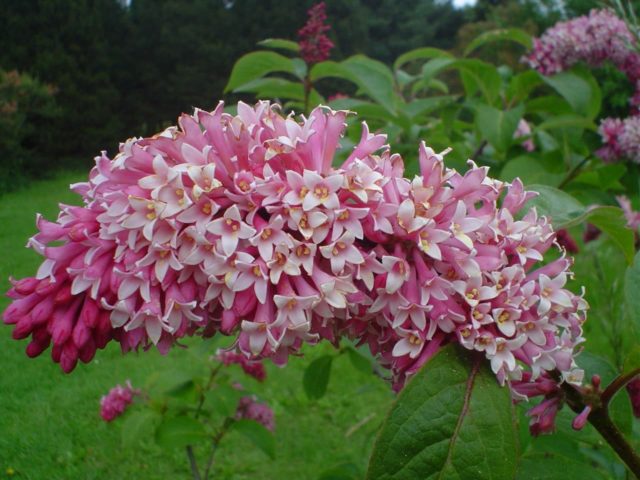

Lilac hairy and drooping
Very similar to the Hungarian hairy or hairy lilac, as well as drooping lilac. Sometimes only experts and breeders notice the difference. All these species are conventionally combined under the general name Hairy. The oval shape of the leaves with pointed tips is their main difference. Small hairs can be seen on them, which gave the name to the whole species. The flowers of the hairy lilac, like those of the Hungarian, are small, but very fragrant.
Lilac drooping has features characteristic only of this species - clusters of inflorescences effectively hanging down. The bushes of hairy and drooping lilacs are quite large and wide. They can be up to five meters high. And the trunks themselves in these species are much thicker than in common lilacs. Absolutely all plants of this species perfectly tolerate temperature extremes and cold winters. They bloom late, so it is advisable to plant them next to other species.
The Preston lilac is very popular, bred by a Canadian breeder who crossed hairy and wilted species. The result is large bushes, reaching four meters, like hairy lilacs. But the inflorescences hang down at the same time. Lilac Preston does not endure the most fierce winter. But they are very unpretentious to the soil.
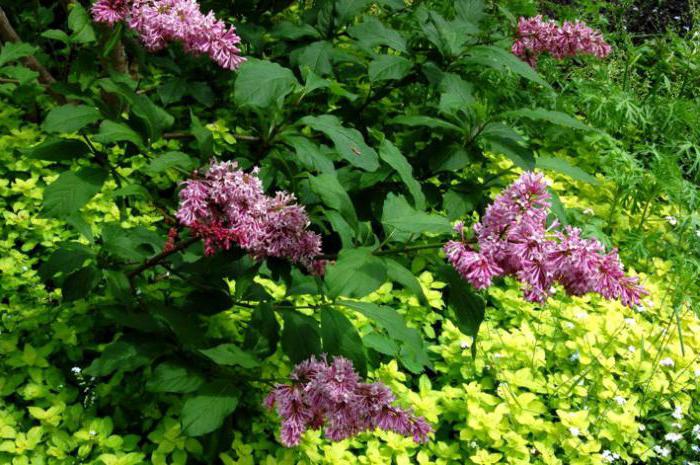

Care and cultivation of Hungarian lilacs
Hungarian lilacs are undemanding to care for. However, it is important to follow the basic rules of agricultural technology.
Watering schedule
Immediately after planting, lilacs are shed with 20 liters of water. After 1 - 2 weeks (when planted in mid-summer), the bush is again shed with the same amount of water. After rooting, watering is rarely needed for the shrub, since the plant receives moisture in sufficient quantities from the soil after precipitation. In a dry season, you can occasionally spill a shrub, preventing stagnation of water in the root system.
After each watering, it is necessary to loosen the soil near the roots so that they can breathe freely.
What can you feed
The first two years after planting, lilacs need only one substance - nitrogen.Therefore, the introduction of ammonium nitrate or urea is recommended. After rooting, the bushes are fed with manure solution (5 parts of water and 1 part of manure). The composition cannot be poured directly under the trunk; it is better to distribute it within a radius of half a meter from the bush. Otherwise, the roots will start to rot and the plant will die.
In the autumn, the lilac shrub needs phosphorus and potash fertilizers. Therefore, it is recommended to fertilize the plant with wood ash diluted in water (400 g per 15 l), potassium nitrate or superphosphates.
Soil mulching
Soil mulching is carried out immediately after planting the seedling. To do this, you can use decayed foliage or manure. First, a layer of mulch up to 7 cm is laid, after the first watering, the mulch is replenished with another 2 - 3 cm layer.
Pruning Hungarian lilacs
Hungarian lilac leaves are very beautiful in themselves and form a graceful shrub shape. Therefore, the bush does not need additional manipulations. Trimming is carried out only when it is necessary to create a more elegant silhouette.
The process is quite simple, due to the ability of the lilac twigs to maintain a given "course" of growth. It is enough to cut the branches at the required slope once in the spring, when active gardening has not yet begun, and the shrub will hold its shape until the next season.
Attention! After flowering, it is necessary to trim the panicles so that they do not take in all the useful trace elements.
Preparing a shrub for winter
Despite their unpretentiousness, young shrubs still need to organize a winter shelter for the root system. To do this, use dry foliage or peat. With the onset of the first cold weather, it is necessary to fill the space near the trunk with the selected material, the shelter layer should be within 10-15 cm. After the bush grows (after about 2 to 3 years), the lilacs can not be prepared for winter.
Attention! Residents of regions with harsh winters still need to play it safe. A small shelter will help avoid freezing of the root system.
Peristolis and persian lilacs
Approximately two weeks later than ordinary lilacs, Persian lilacs and pinnate lilacs bloom. Until now, the aforementioned species can be found in the wild in Afghanistan, as well as Iran and Turkey, in the North Caucasus and in some areas of Central Asia.
The cirrus lilac in bloom may not be so spectacular, but the unusually narrow, saturated dark green leaves look very original. These varieties grow up to three meters, but no more. Their inflorescences are very dense, even thick and have a pleasant aroma characteristic of these species.
Persian lilacs are usually pink or white. Varieties of Persian and pinnate lilac also differ in their hypersensitivity to cold climates and sudden temperature changes. However, they do not require intensive and constant watering. Not too demanding to care for.
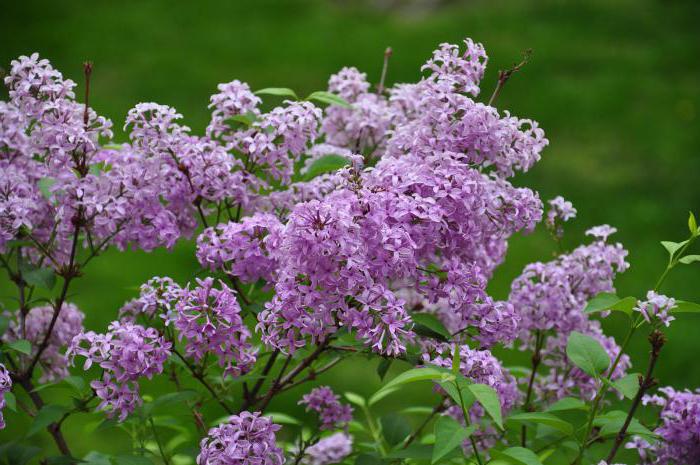

Pests and diseases of the Hungarian lilac
Despite its unpretentious care, Hungarian lilac still suffers from a number of pests and diseases. Being in the open ground, the plant is trapped by such enemies as ticks, speckled moth and scale insect. All of them are capable of causing irreparable harm to the shrub, which can be fatal for it. Therefore, it is worth treating the lilac in a timely manner with special preparations purchased in the store. If the pests have already spoiled parts of the plant, then the affected branches and foliage must be cut and burned.
Among the diseases are fungal phyllostictosis, viral mosaic and spotting. All these pathologies require immediate treatment with specialized drugs. Otherwise, other plants on the site may suffer.
Attention! As a preventive measure against various kinds of diseases and pest attacks, you can use folk methods.The shrub can be periodically sprayed with a solution of tomato tops or with essential oils diluted in water.
Tree-like
Another variation. Continuing the conversation about what types of lilacs are, in the photo we see tree lilacs. Breeders often distinguish this species as a separate genus. This is due to the fact that his flowers are much more like privet. Large and fluffy creamy inflorescences of small flowers with yellow stamens are formed from a lateral bud at the end of last year's shoot and give off a pleasant honey aroma.
There are many types of lilacs. But tree-like varieties look very impressive against the background of bright green leaves. They bloom very late - not in spring, but in summer, a couple of weeks later than Hungarian varieties. The plant reaches eight meters in height. And its width can be five meters or even more.
Hungarian lilac: features of the type and tips for care
It is not the first year that a lilac bush has been growing on the site, but in no way wants to bloom. I bought planting material in the nursery, where they guaranteed that next season it would decorate my garden.
I began to figure out what I did wrong. After transplanting to a new place, my beauty thanked me with lush and long flowering. I share all the information I have collected.
Feed in spring and autumn
Lilac Hungarian
- Remove inflorescences. After the lilac blooms, it is imperative to remove the inflorescences so that they do not pull power from the bush. Pruning is done before the second bud, next year it will give a new inflorescence.
- Plant in July. Lilacs should be transplanted in the month of July, when flower buds are laid. If everything is done correctly, then the young bush will bloom in the spring.
- Carry out care. In addition to annual pruning, the lilac bush needs feeding and protection from pests. In autumn or spring, lilac needs organic fertilizers, and after flowering complex mineral fertilizing is responsive. 5 years after planting, the plant will produce shoots that can be transplanted.
Channel "Fazenda" gives advice on the care of lilacs.
Chinese lilac
No less popular. This type of lilac was not found at all in China, but in France. The plant is a natural hybrid. It was found by botanists in the Rouen Botanical Garden. The name Chinese lilac can be considered in fact erroneous, since it resembles Persian lilac. Against the background of small, pointed leaves, pinkish-lilac small flowers look delicate, very beautiful, emitting a characteristic aroma.
Examining the lilacs, species and varieties in the photo, you can always see specimens of Chinese plants. They are also terry. In central Russia, Chinese varieties are likely to freeze if it gets too cold. However, when there are no large temperature changes, she feels great. Chinese lilac blooms luxuriantly and early, blooms for quite a long time - up to fifteen days.
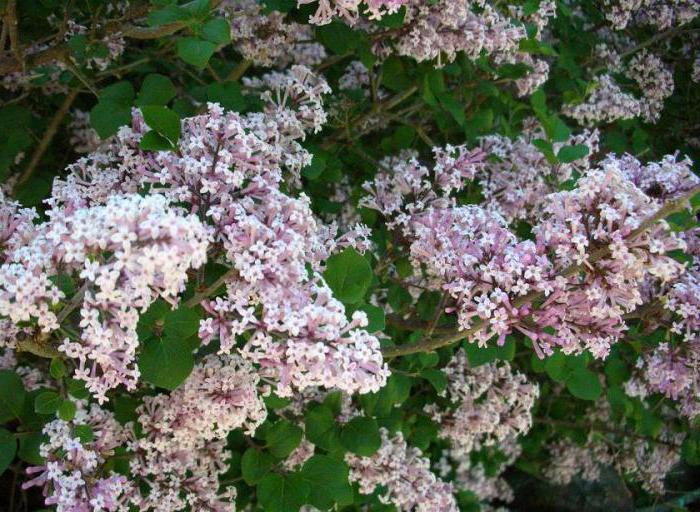

Outdoor care for lilacs
After planting, the bush must be properly looked after. There are no special requirements, here is a description of some of the rules:
- abundant watering, but you do not need to be zealous.
- regular loosening of the soil in spring and summer, this is done every two months.
- after planting for two seasons, the plant requires nitrogen fertilization.
- starting from the third year of life, manure is required for feeding, which is diluted in a 1: 5 ratio. It is important to apply the fertilizer correctly, it should not get on the trunk. The procedure is performed once a year.
- an adult plant requires mineral formulations that contain potassium and phosphorus. Fertilizers are applied according to the instructions in the spring, until the end of flowering.
- pruning in order to rejuvenate the bush is not performed, only formative, if required. In early spring, you can thin out the inner branches, and after flowering, remove wilted buds.
- for the winter period, you only need to cover young bushes and a newly planted seedling. For this, foliage or dry peat 10 cm thick is useful.
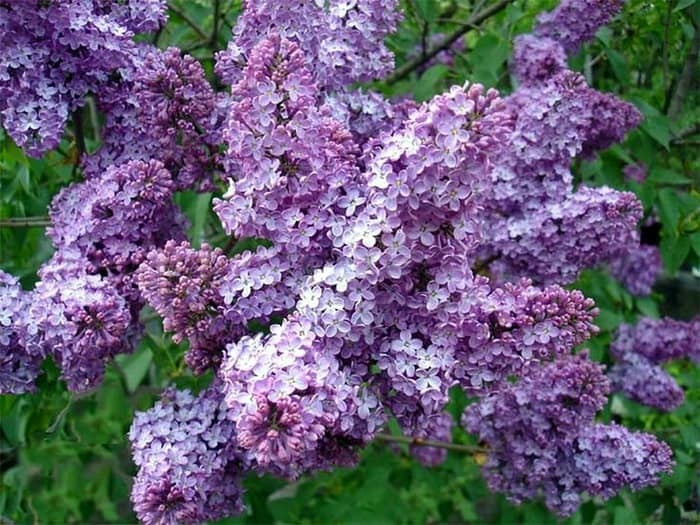

Lilac variegated
Very beautiful plants. These types and varieties of lilacs bloom early (already at the end of April). The pink-white buds give off a characteristic aroma. The bush can grow up to four meters in height. But it does not set seeds, as it is a hybrid of pinnate and broadleaf lilacs.
This species has large leaves and short shoots, the inflorescences are oval and rather large (about 15 cm in length). When the variegated lilac only blooms, its corolla is pink-lilac. But by the time it blooms, it becomes completely white. The variegated lilac thrives in cold climates. She is not afraid of a prolonged drought.
Pink terry lilac
Pink varieties are found with regular and double flowers. The plant got this name from the predominant color of the corolla. Lilac pink and purple belong to the group of terry lilac.
Beauty of Moscow
This lilac is considered the best in originality. The bush is medium in height, wide. Large panicles in the form of a pyramid, collected in inflorescences up to 25 cm. There are one or two pairs. The buds are pink-lilac, rather large, double. Opening up, they form pink and white flowers. Possesses a pronounced aroma. Large, elongated leaves grow, ovate with a pointed tip. Medium flowering long-flowering cultivar.
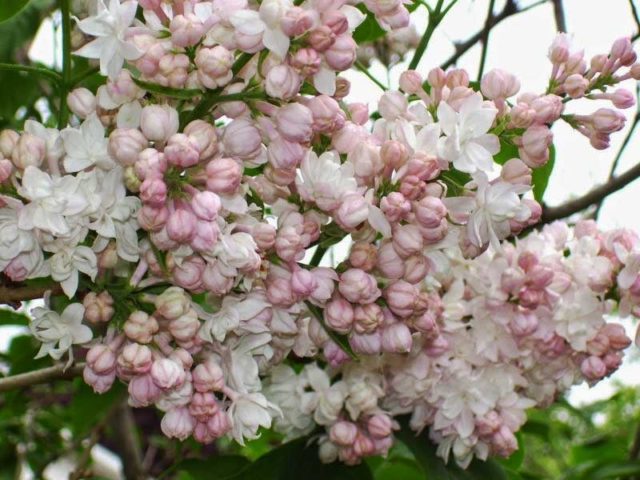

Olympiada Kolesnikov
The bush grows high - up to 3 m. The inflorescences are large, pyramidal, pale pink in color. The buds are elongated, large, bright purple. They are formed by 2 or 3 rows of petals. The lower rim is set aside from the rest. Lilac-pink petals in them, twisted in different directions. The flowers are fragrant. Dark green leaves. Annual, dark-colored shoots grow. Medium flowering variety. Abundant flowering, long lasting.
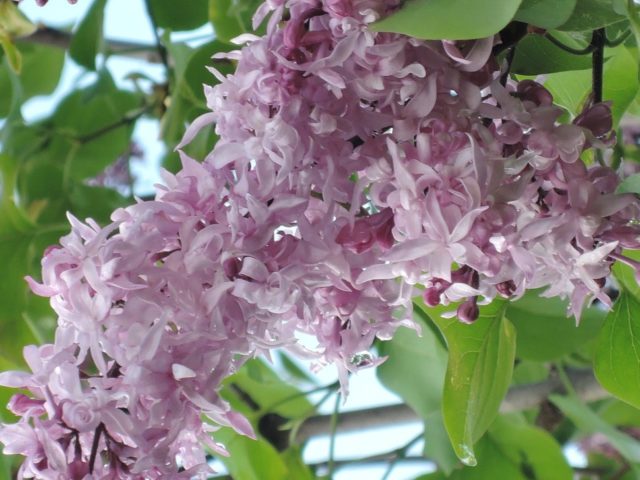

Madame Anthony Buchner
The shrub has decorative qualities. It is common. The flowers are colored in different shades of pink. They have a pronounced aroma. In diameter, each flower reaches 2.7 cm, star-shaped, dark pink in color. Medium flowering plant with moderate bud formation. It has dark green broad leaves. They grow tall - up to 4 m, wide bushes. Lilac is photophilous, tolerates droughts well. Resistant to frost in temperate climates. Prefers fertile soil, good drainage.
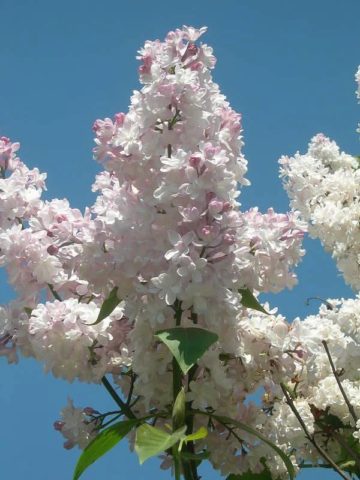

Moscow morning
The bushes are tall but compact. The plant forms dense double buds. In the corolla, the petals create 4 rows and have different shapes. Coloring lilac-pink with mother-of-pearl. Half-open buds look like a ball. The color does not change in the sun. It has large green leaves. The variety has a strong aroma. Bloom in late spring is moderate.
Important! Lilac Moscow morning does not fade in the sun. She can suffer from late spring frosts.
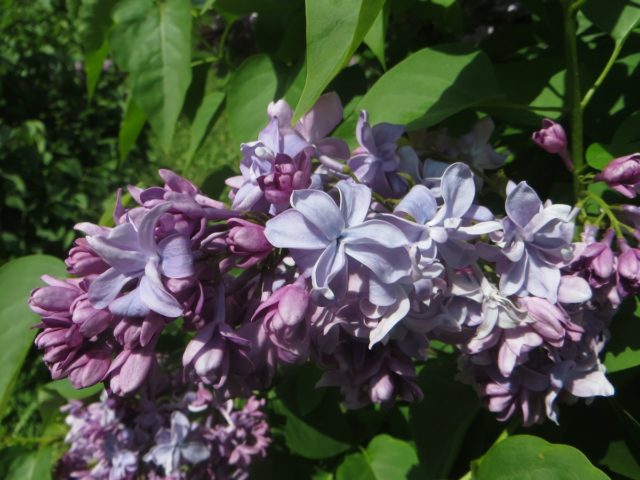

Aphrodite
Variety Aphrodite forms cone-shaped inflorescences. The buds are rounded, dark pink in color with a fawn tinge. Corollas are large, asymmetrical. The central, pale pink petals do not cover the middle. The inner part of the petals is lighter. Flowering dates are late. Light-loving shrub, tolerates partial shading, does not like highly moist areas. Prefers fertile, drained soil.
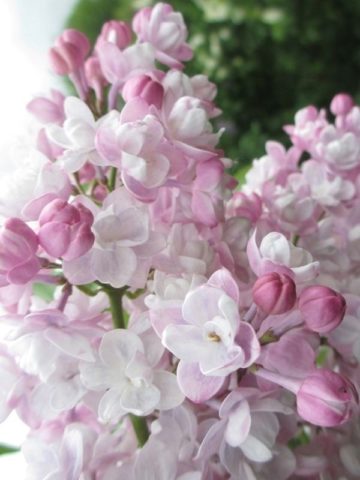

Dwarf
These species always look good, they are often used in small gardens to form original compositions. Or as an original decoration on the lawn in front of the house.
The most popular varieties are Meyer's lilacs. These miniature bushes need a little space, since they do not grow more than a meter in height. Often, dwarf species are grown in special containers, and they thrive there. Lilacs of the Meyer variety bloom early, very abundantly and luxuriantly. Its peculiarity is the repeated flowering in autumn.
In winter, dwarf lilacs need to be reliably covered. Wide and spreading miniature shrubs no more than one and a half meters wide and high, grow extremely slowly.For this reason, it is advisable to use it for arranging mixborders.
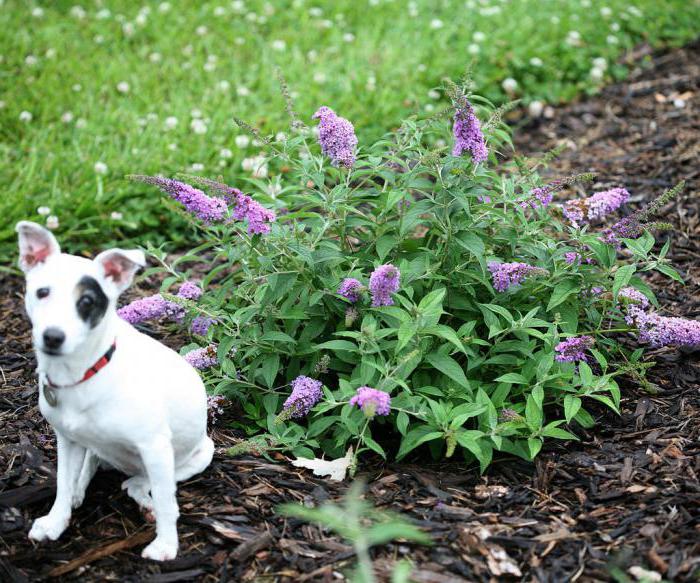

So, you learned what types of lilacs are, names and photos. But this is far from a complete overview. It remains to add that this shrub grows and blooms best in abundant light and on fertile lands. Some types of lilac can withstand frosts of up to thirty degrees and live up to a hundred years. The officially registered long-liver is a common lilac bush that has reached 130 years of age, planted in 1801. It had a crown with a diameter of 11 meters. Different types of lilacs perfectly clean the air from dust and various harmful impurities and are not afraid of the gas pollution of the atmosphere.
About vaccination on video
Many lilac growers dream of planting lilacs, because many luxurious varieties are capricious. In the video below - in detail about the vaccination.
The Latin name for lilac is "syringa", derived from the Greek name "syrinx", which means the structure of the flower. According to one of the other versions, the name of the lilac comes from the nymph Syringa, which turns into a reed, with the help of which the forest god Pan made a shepherd's pipe called "syrinx".
Hungarian lilac
There are about 28 varieties in the genus, some of which are widespread in culture. In nature, lilacs can be found only in the mountainous region of Eurasia. In European territory, more precisely, in the Balkans, both common and Hungarian lilacs are celebrated in such places. On the territory of Asia, the homeland of such varieties of lilacs as the Himalayan, Afghan and Persian are the Western Himalayas, and many species grow and are cultivated in the East Asian mountains - a vast region, where Japan, Korea and Primorye.
Crohn: is dense and at the same time ovoid in shape, which reaches about 4 meters in height and the same in width.
Growth rate: fast. During the year, this bush can grow to about 35 centimeters.
Longevity: The plant can grow for up to one hundred years.
Flowers: lilac, tubular, they are collected in a pyramidal apical inflorescence, 0.6 centimeters each. The flowering period is from May to June. Basically, this flower blooms for about two weeks.
Foliage: dark green color. In the autumn, the foliage acquires a yellow color. The leaves are broadly elliptical, about 10 centimeters long.
Preparing for winter
The high frost resistance of the shrub greatly facilitates its preparation for winter. Hungarian lilac is not demanding for winter shelter and even tolerates northern cold weather well. If the shoots are accidentally damaged by frost, in the spring they will quickly recover even without outside help (Figure 7).


Figure 7. Due to frost resistance, the culture does not need additional shelter for the winter
Winter hardiness is manifested not only in adult shrubs, but also in young seedlings. They also do not need additional shelter, even if they were planted in the fall.
You will learn more information about caring for this decorative crop in the video.



